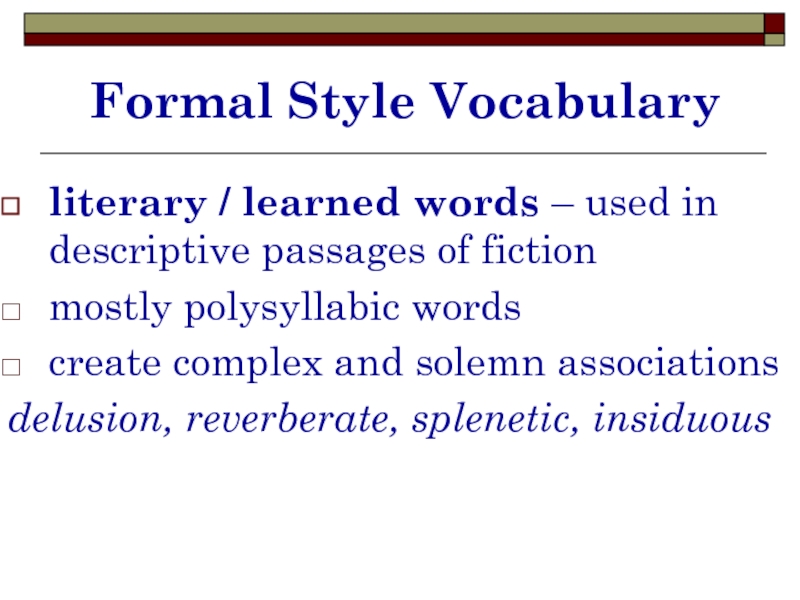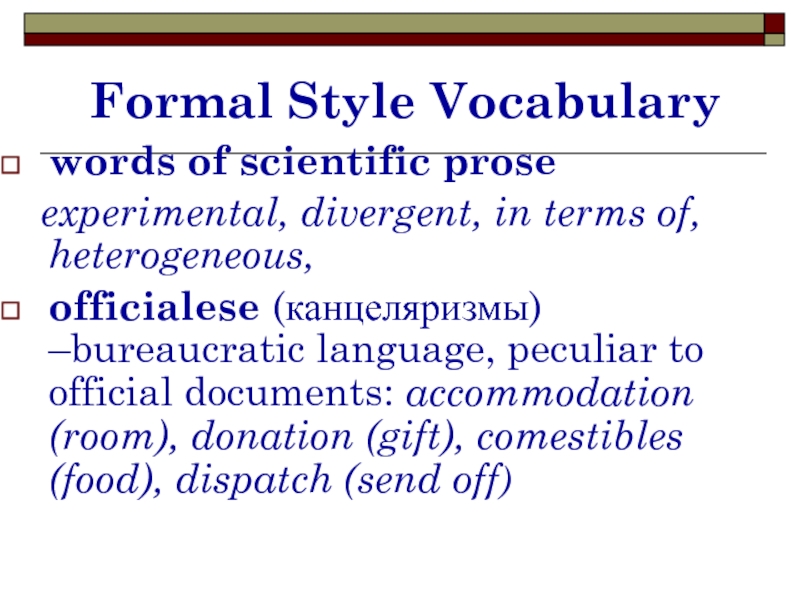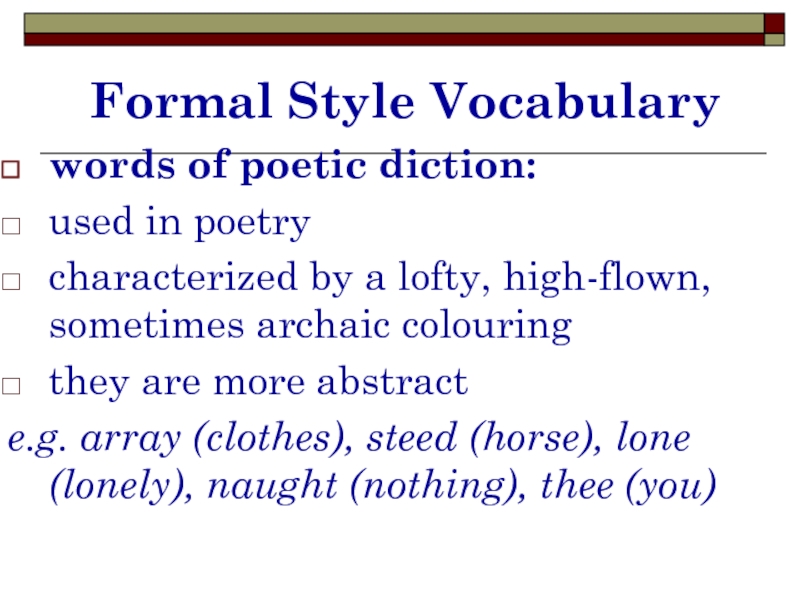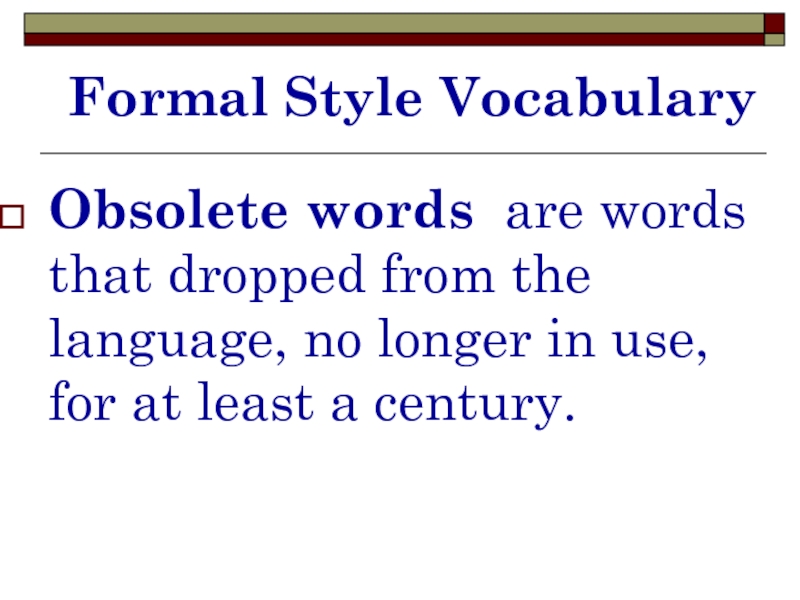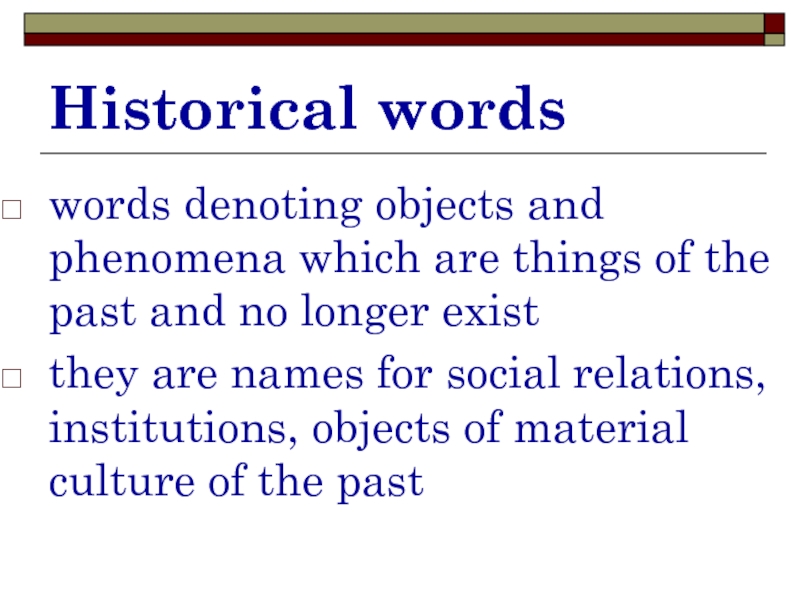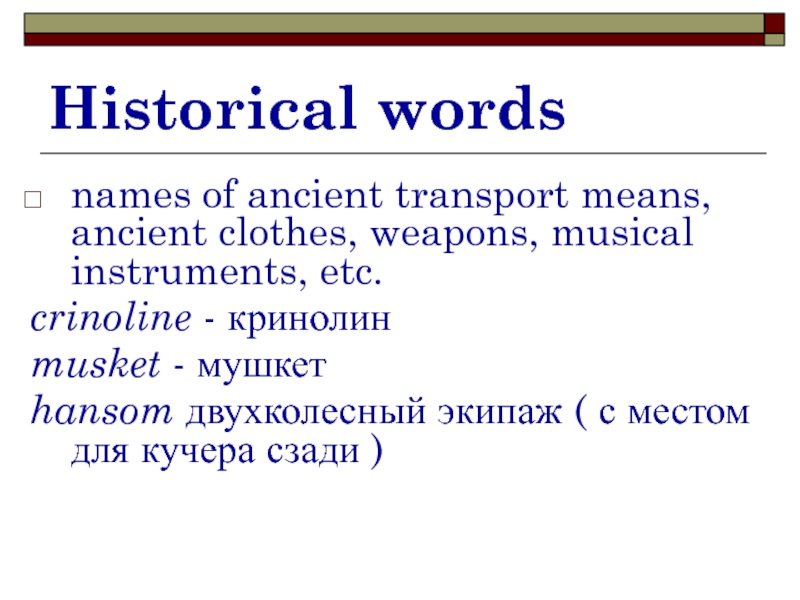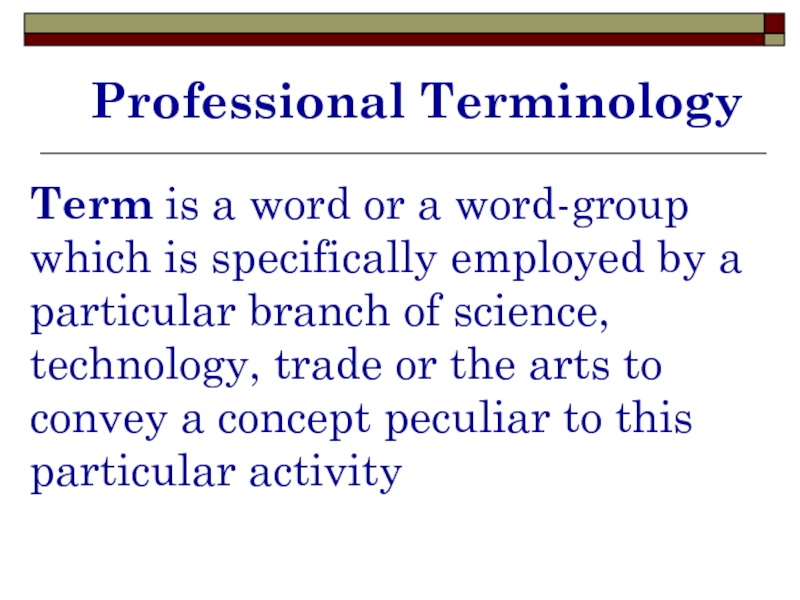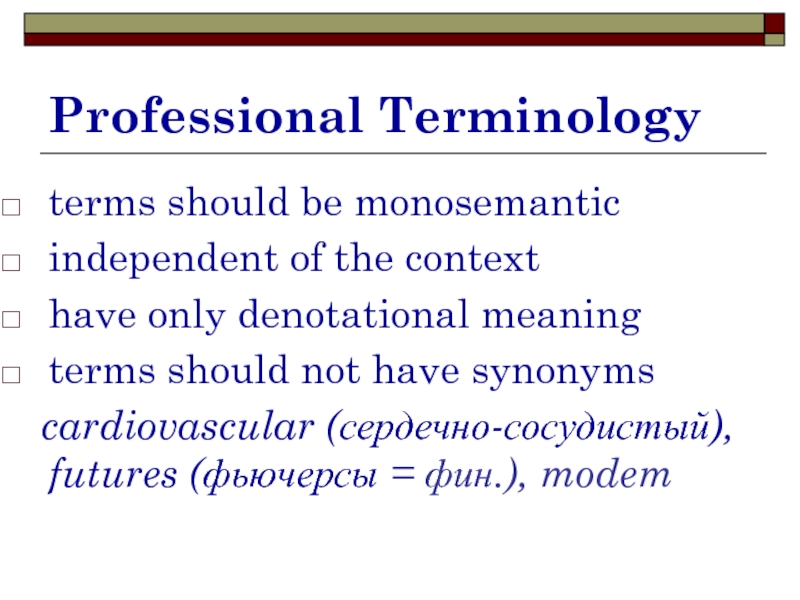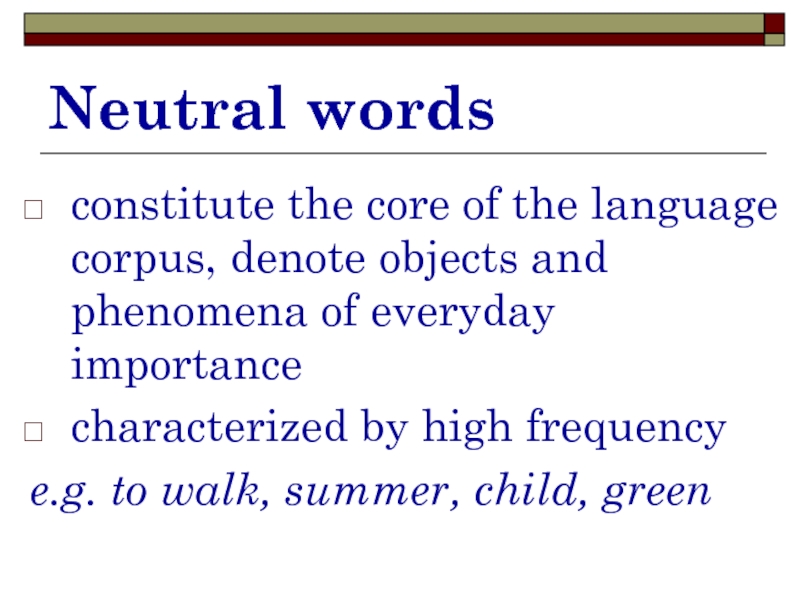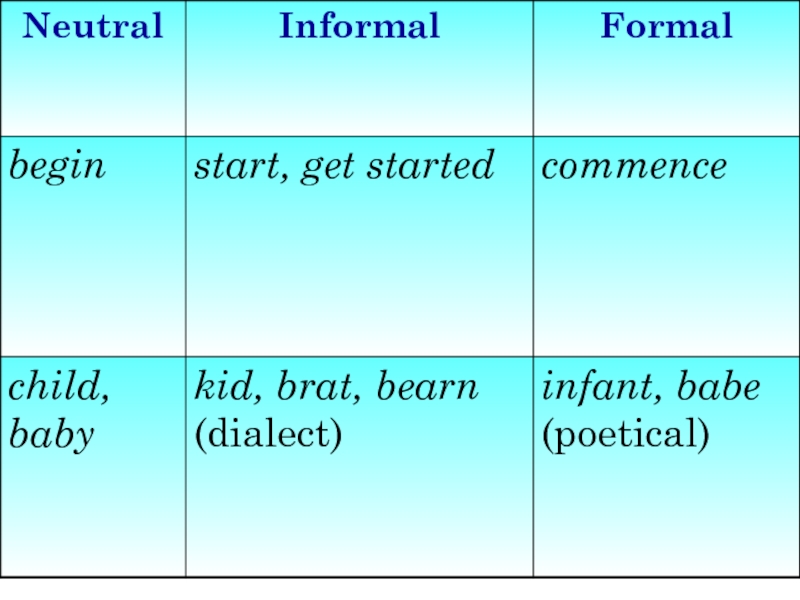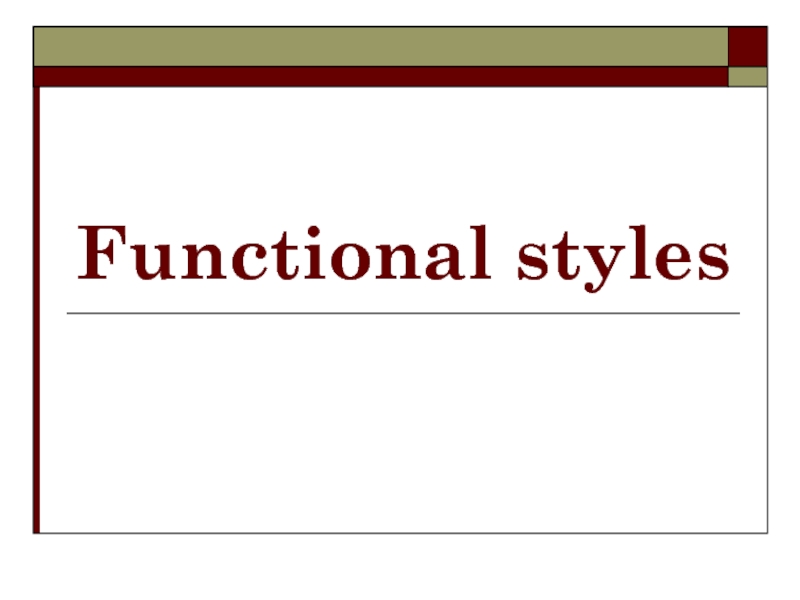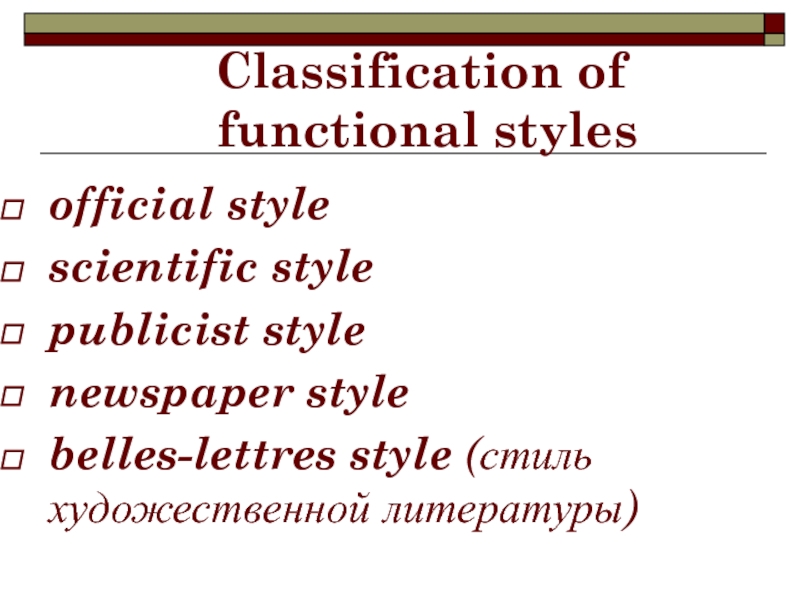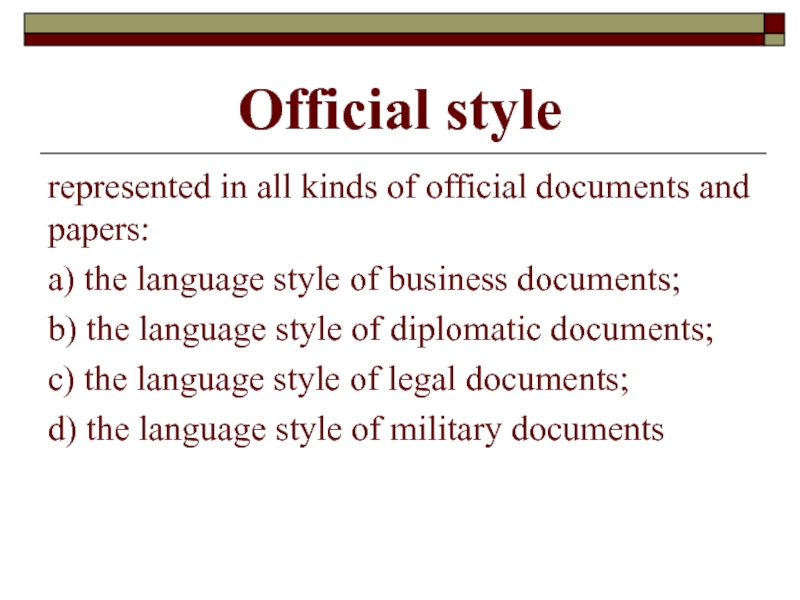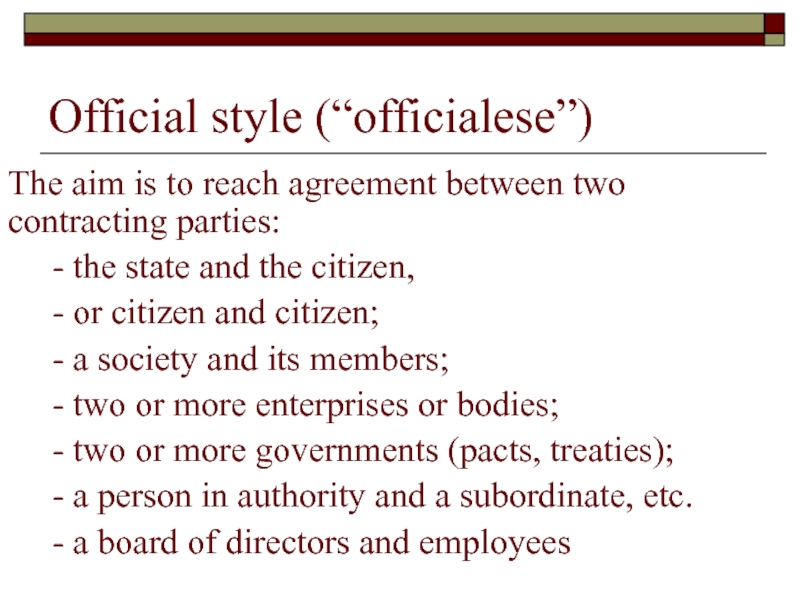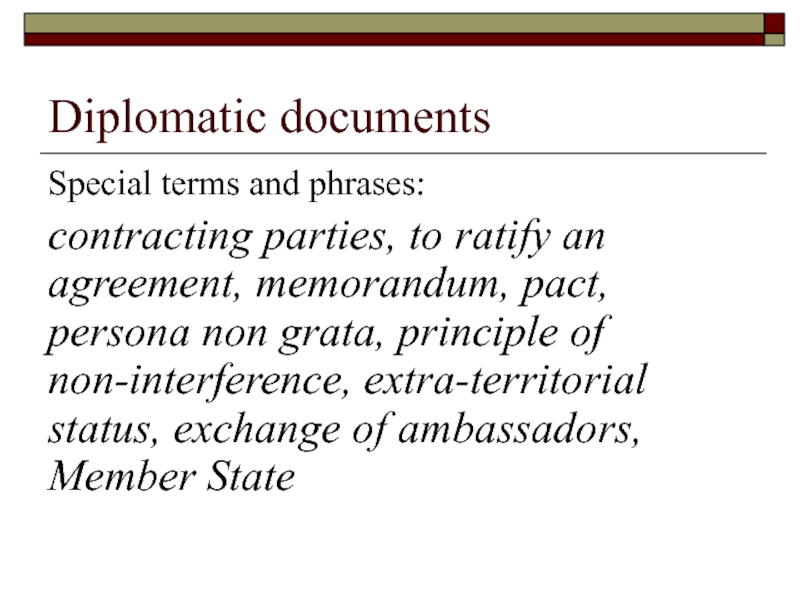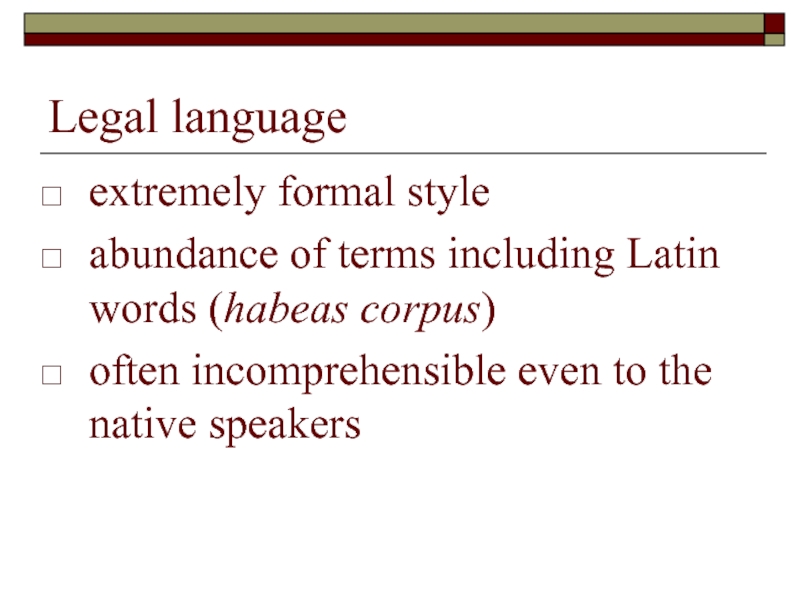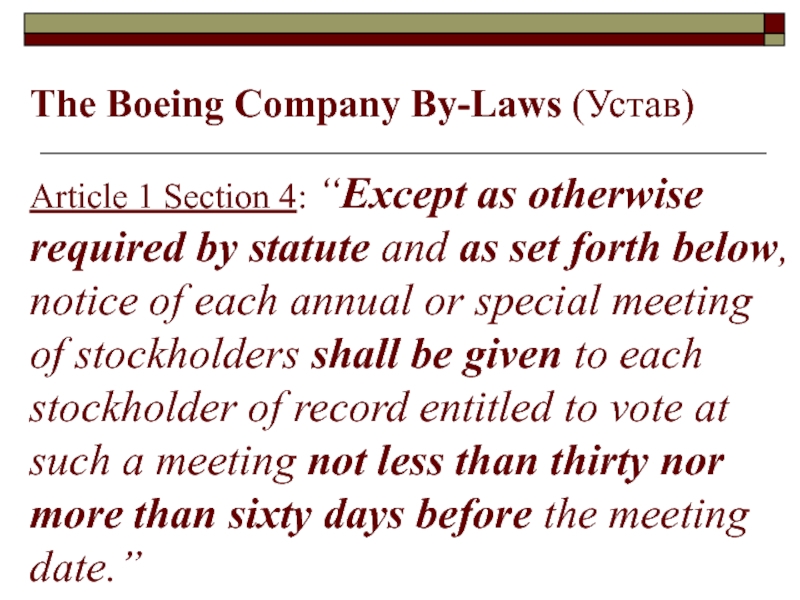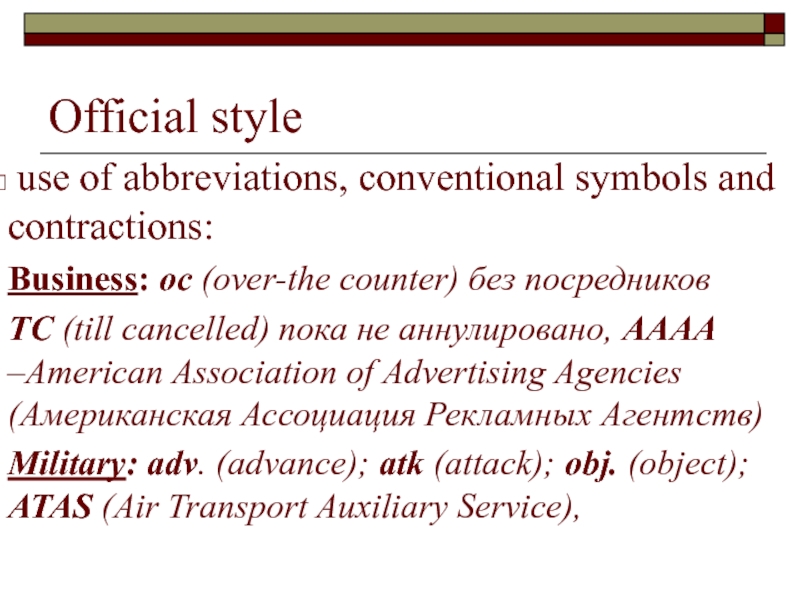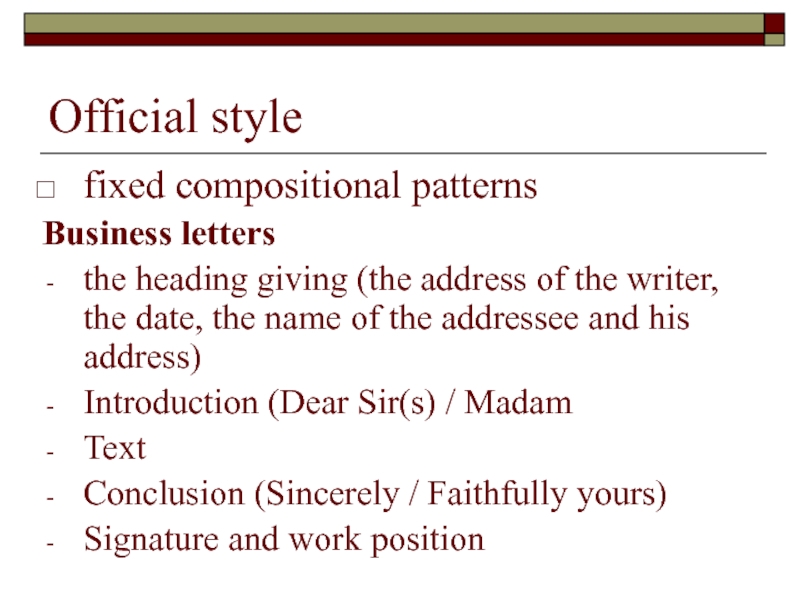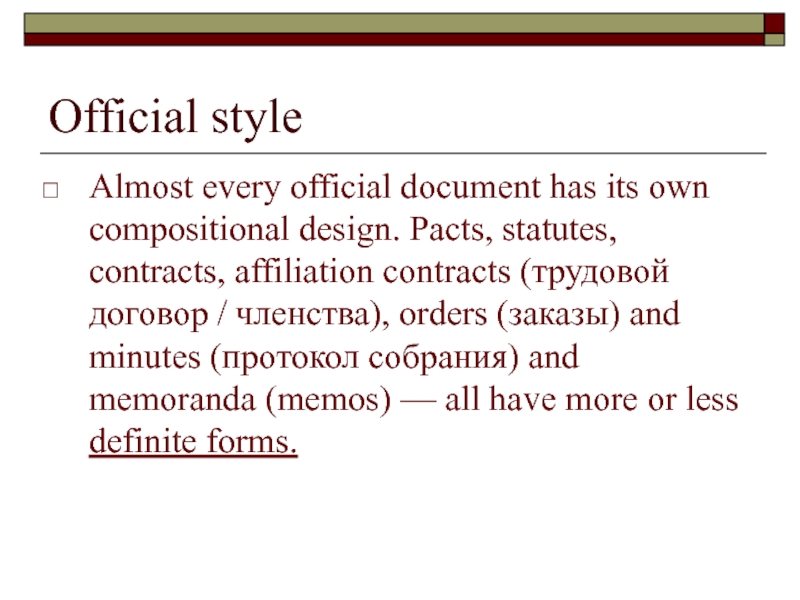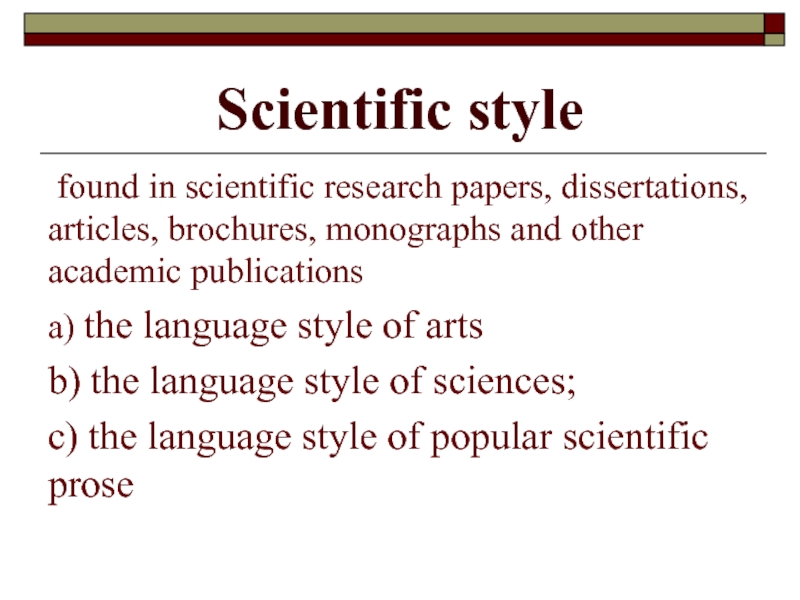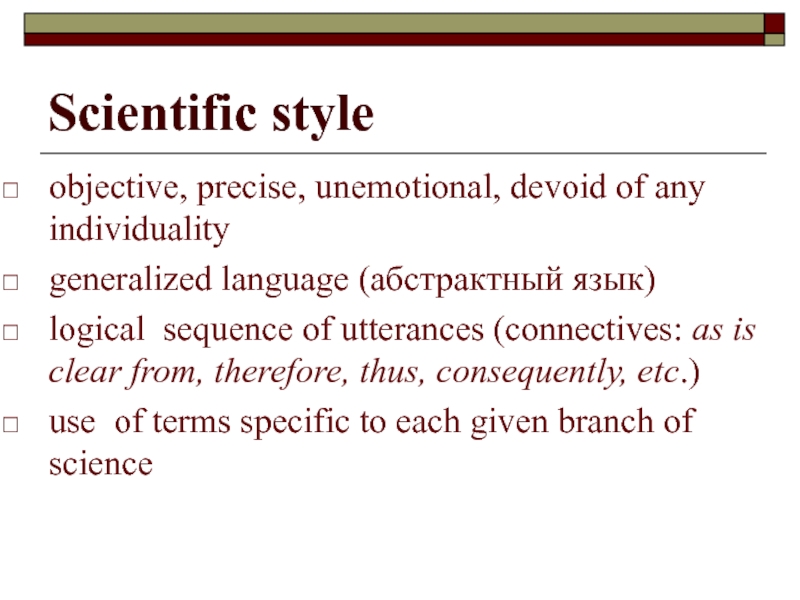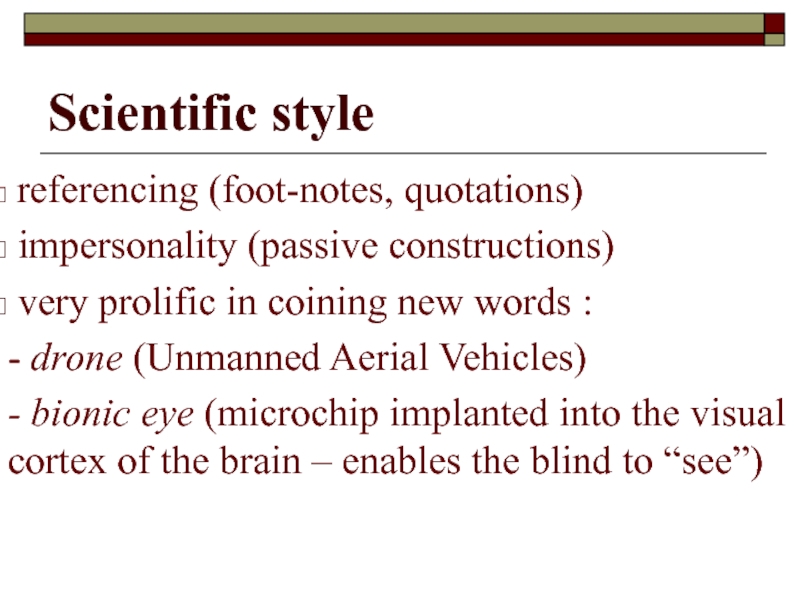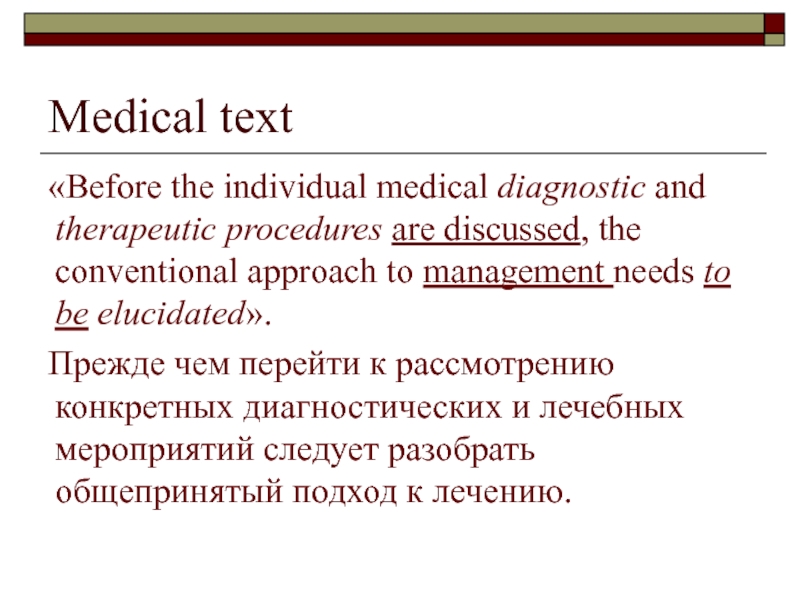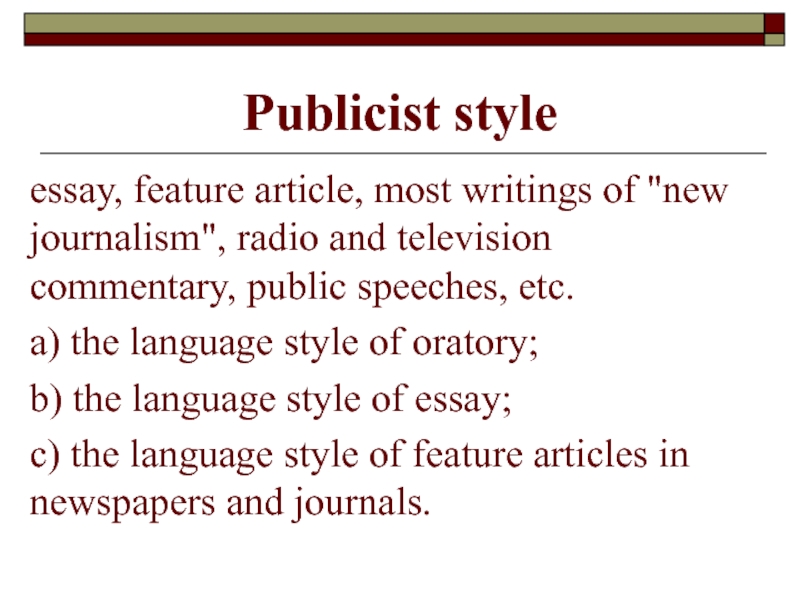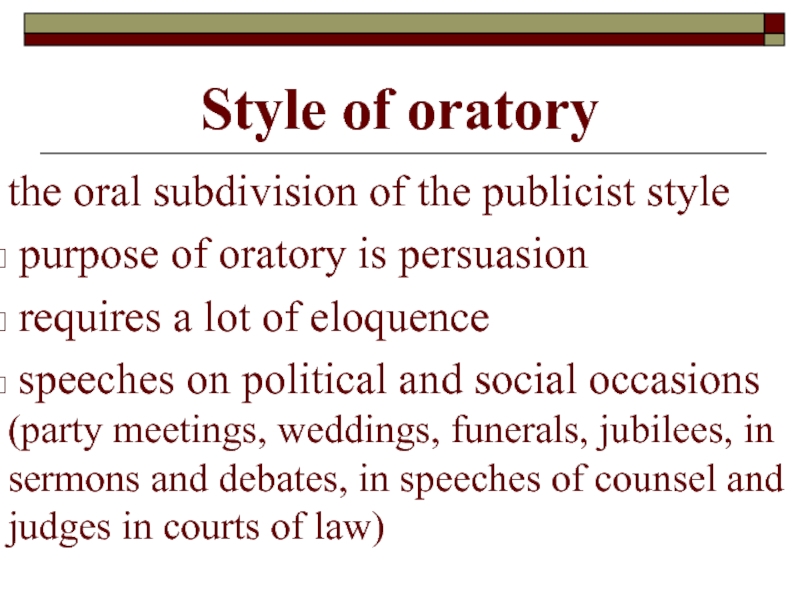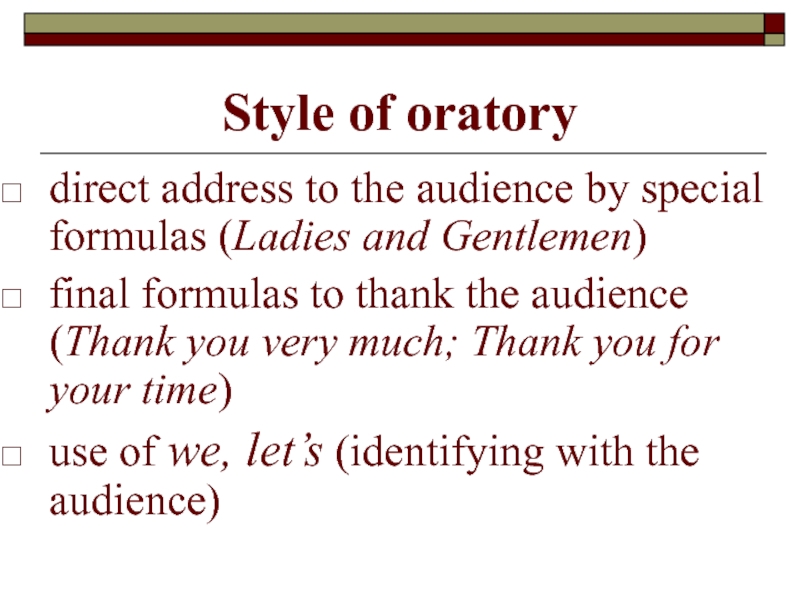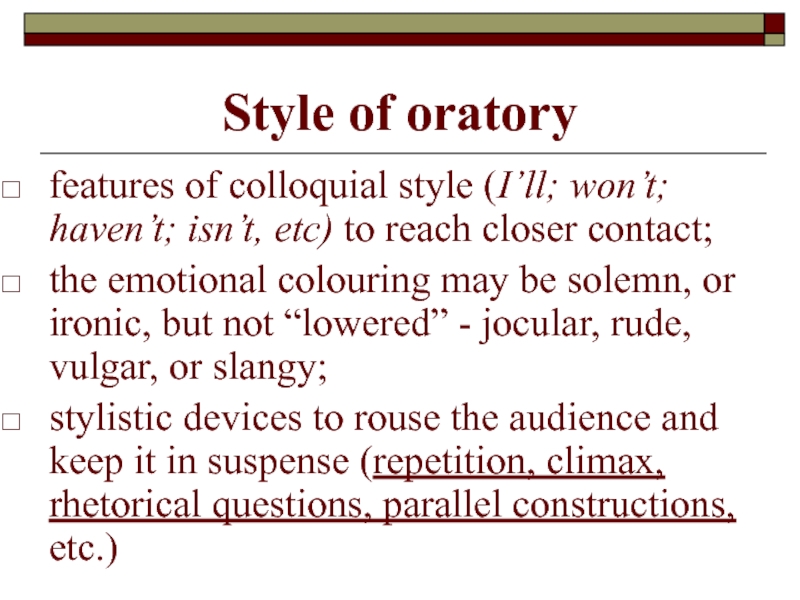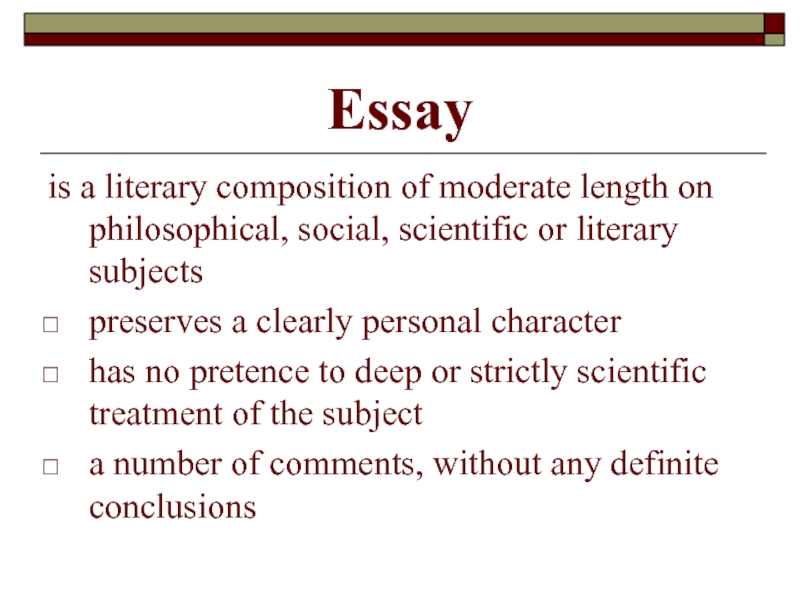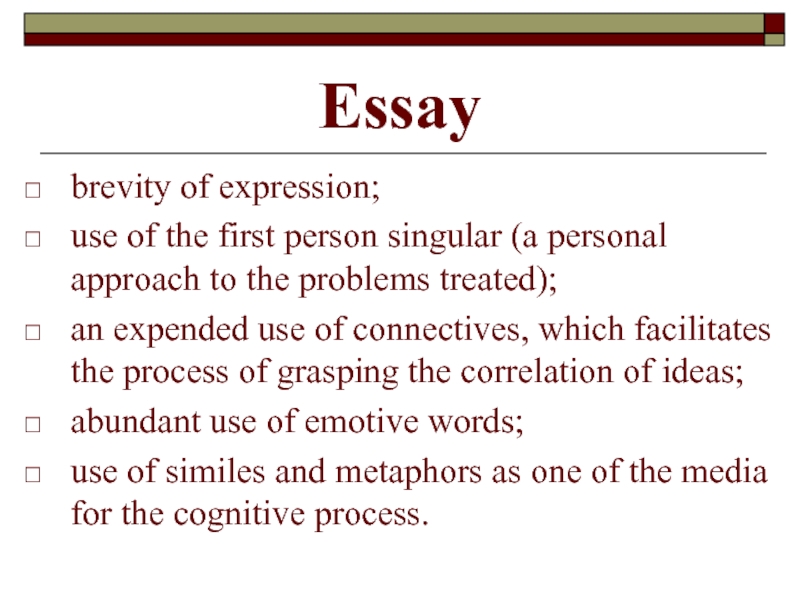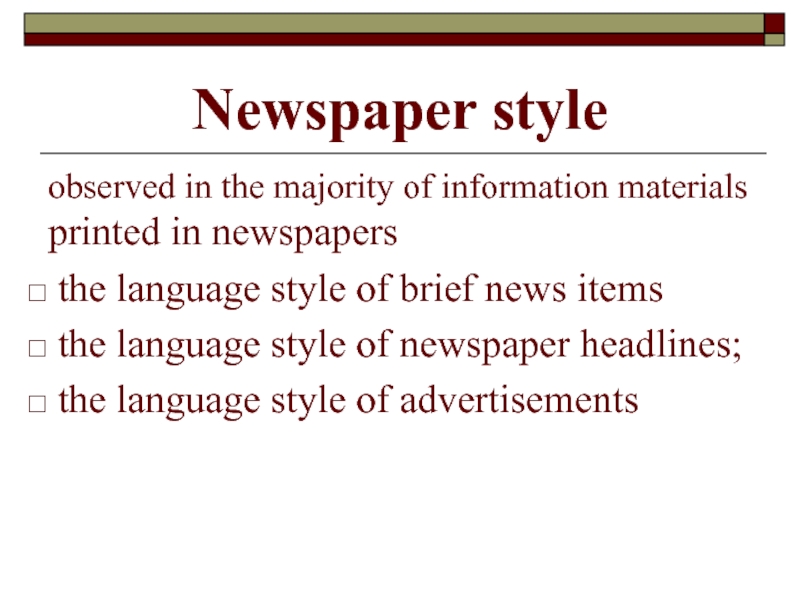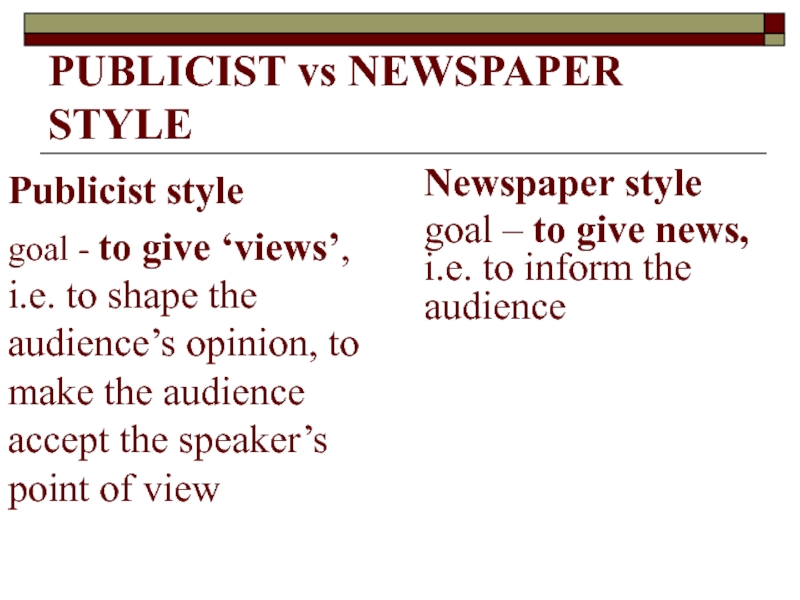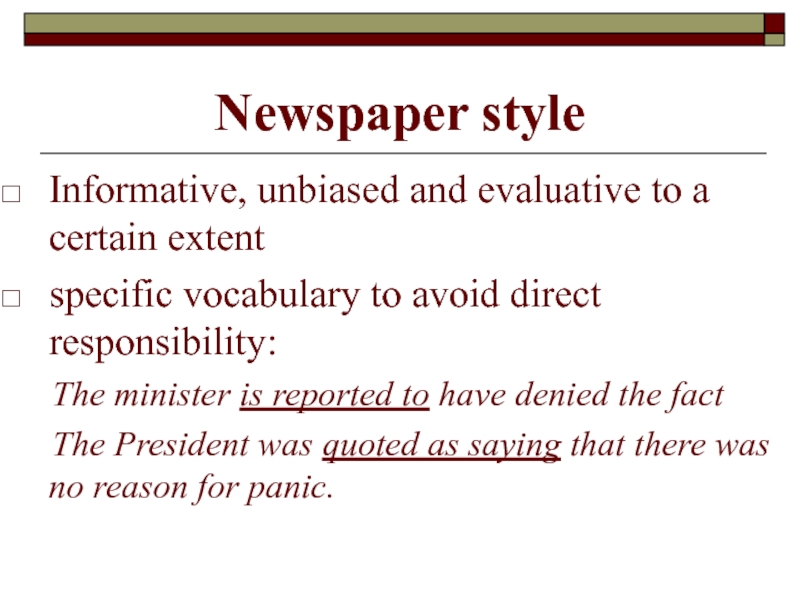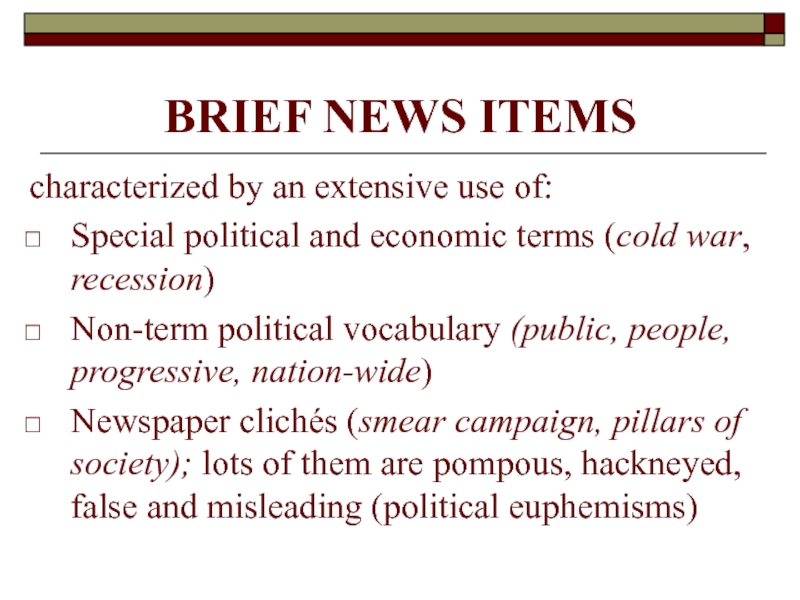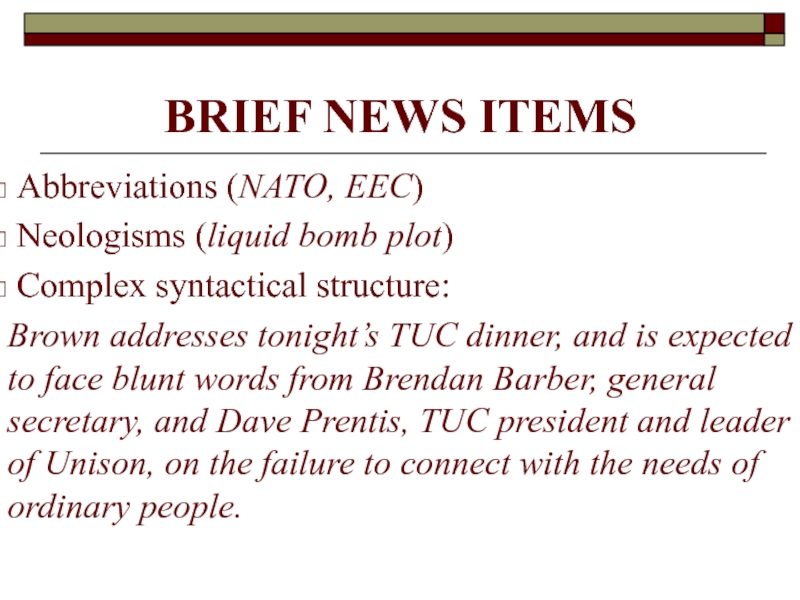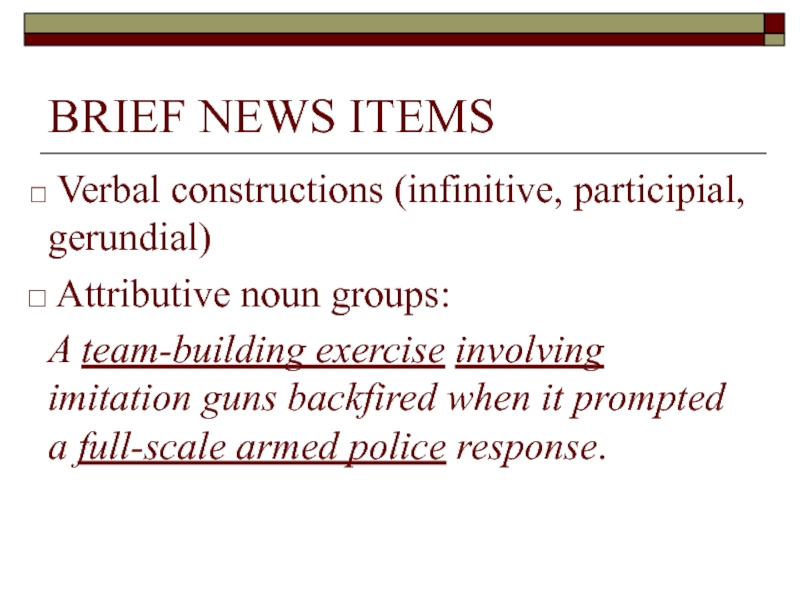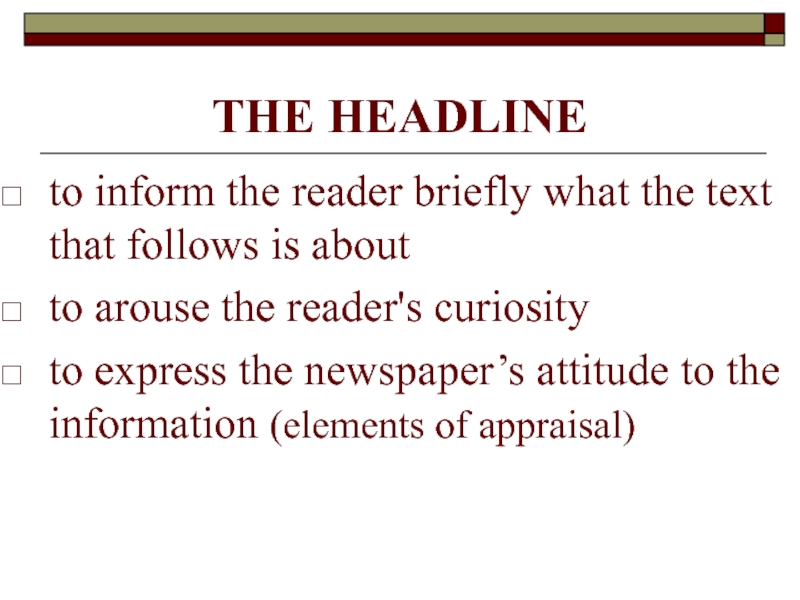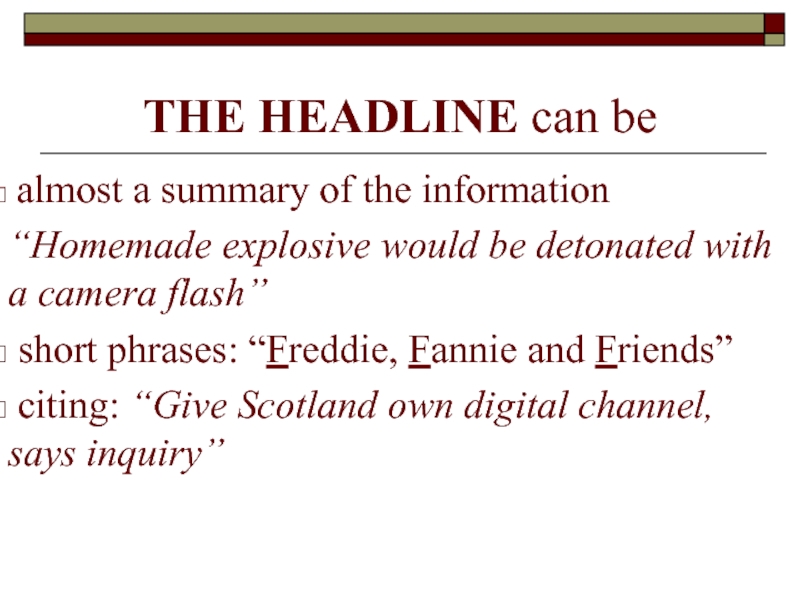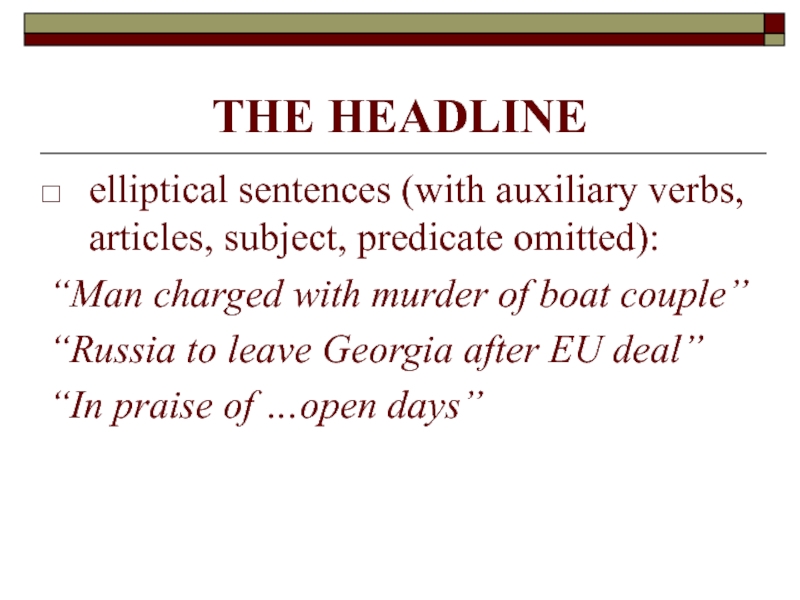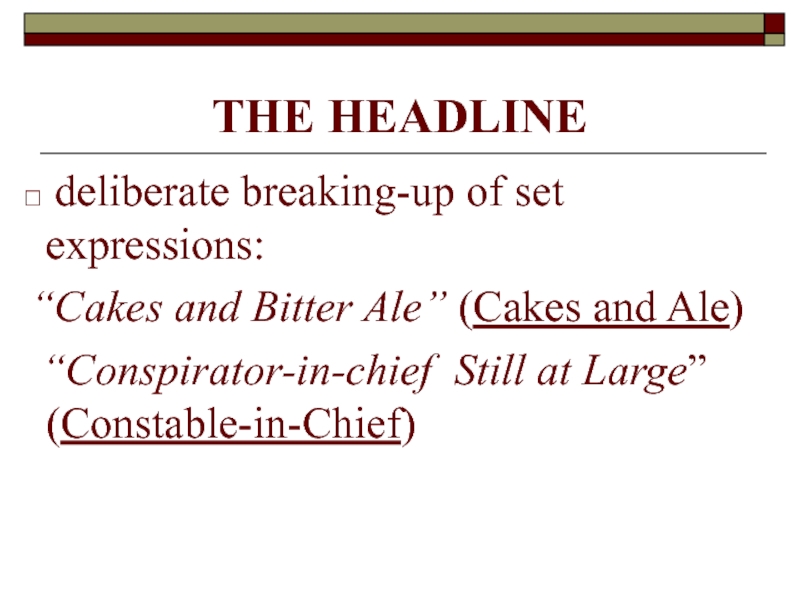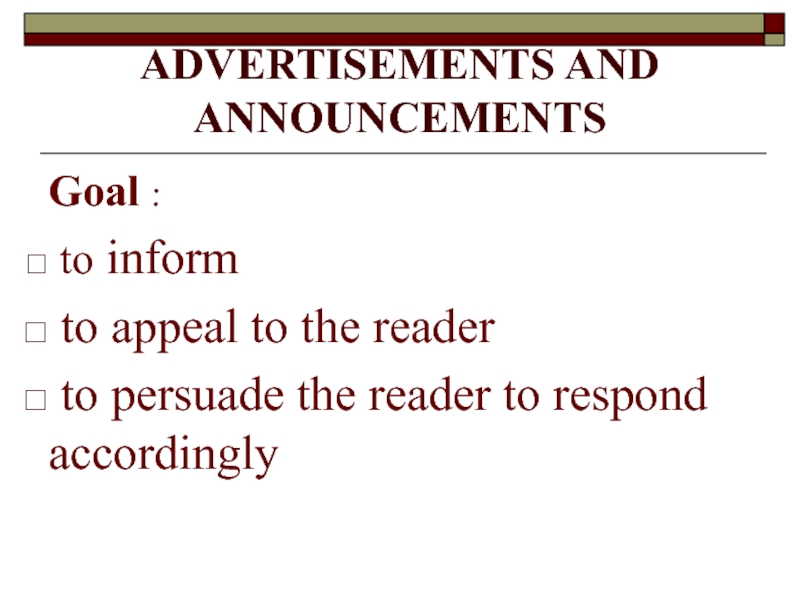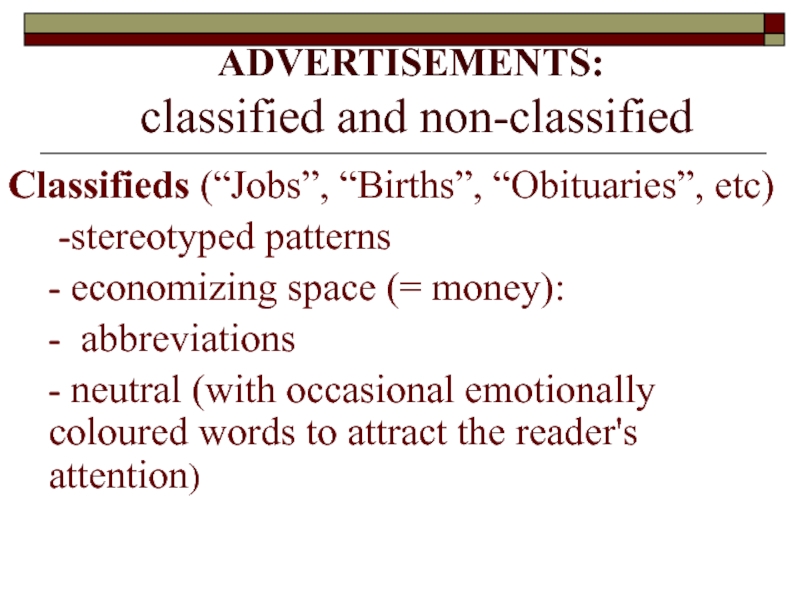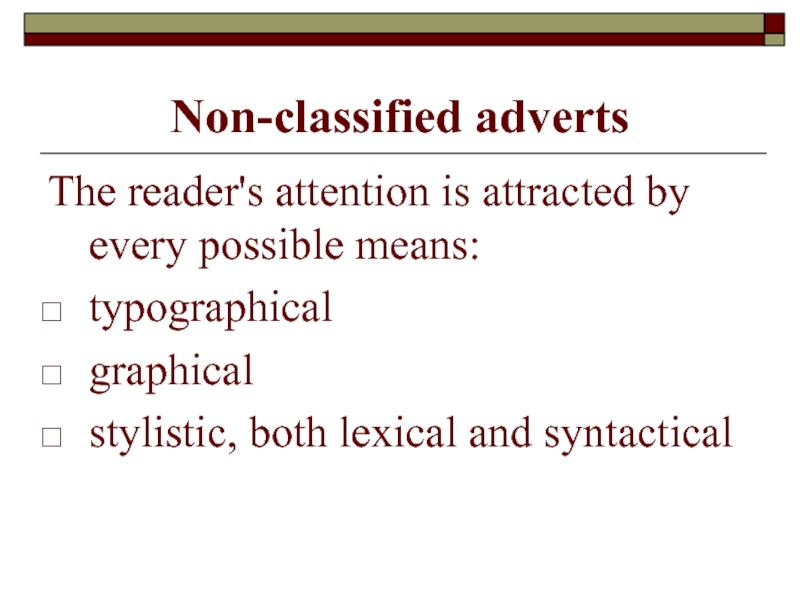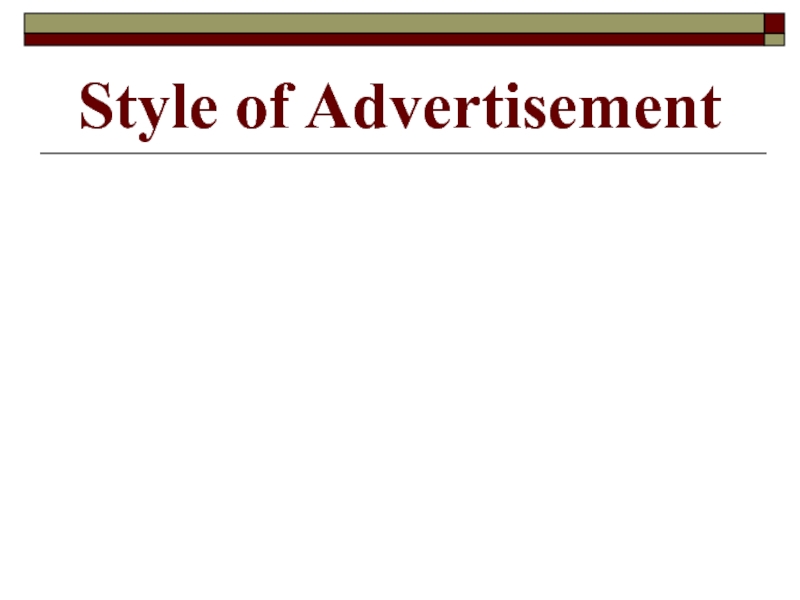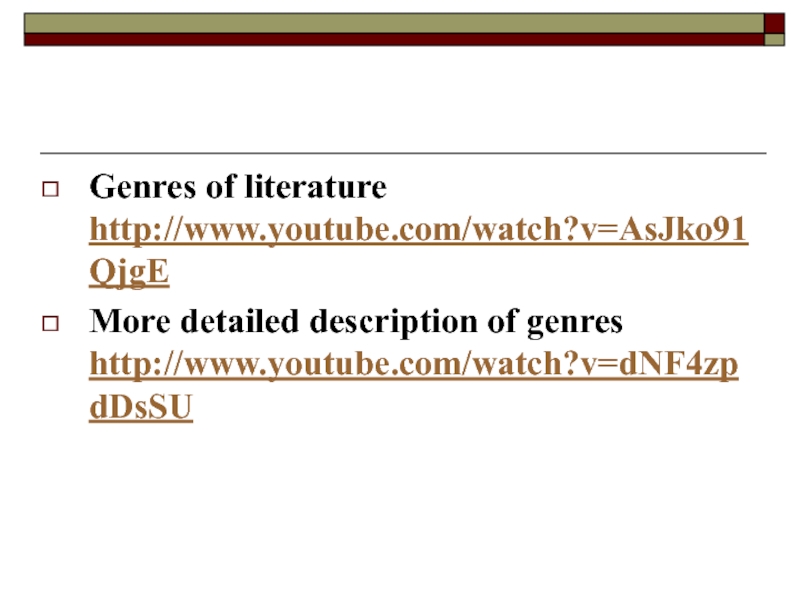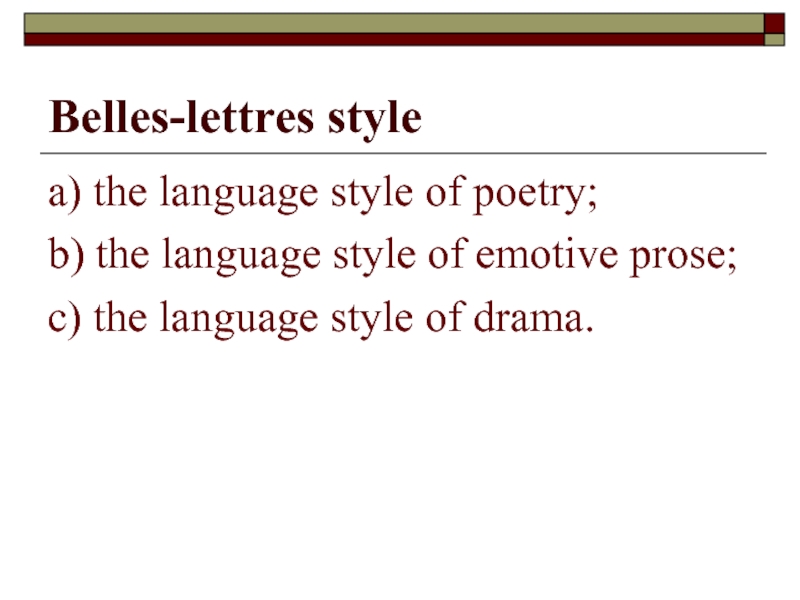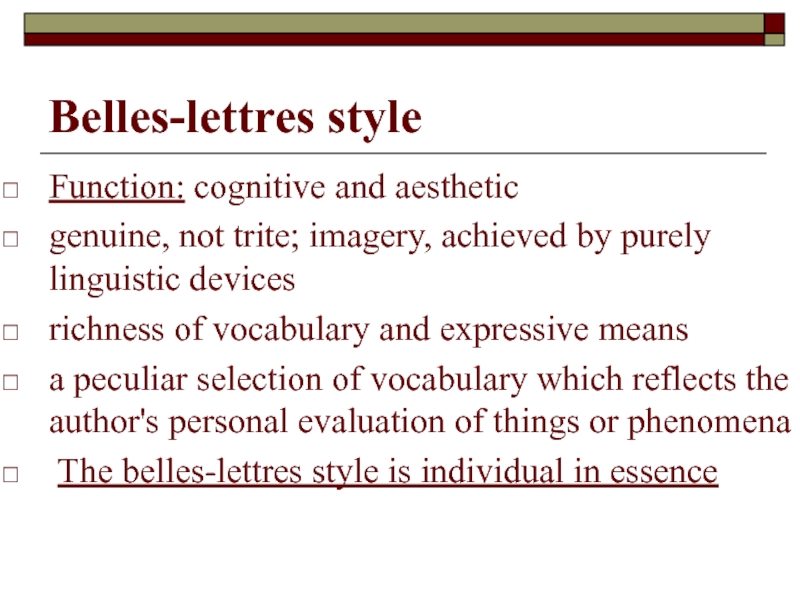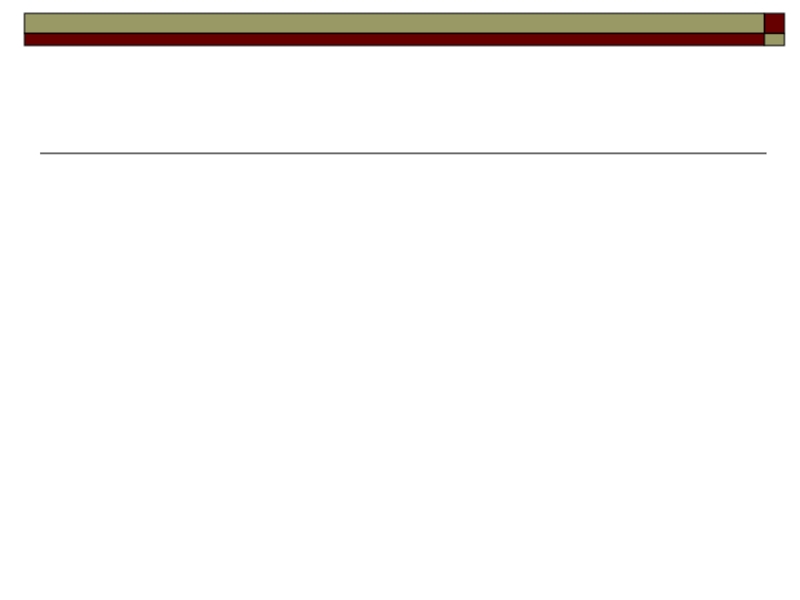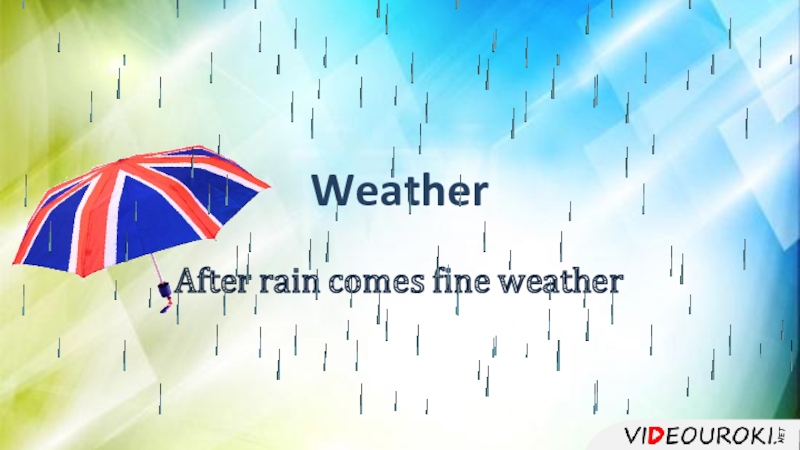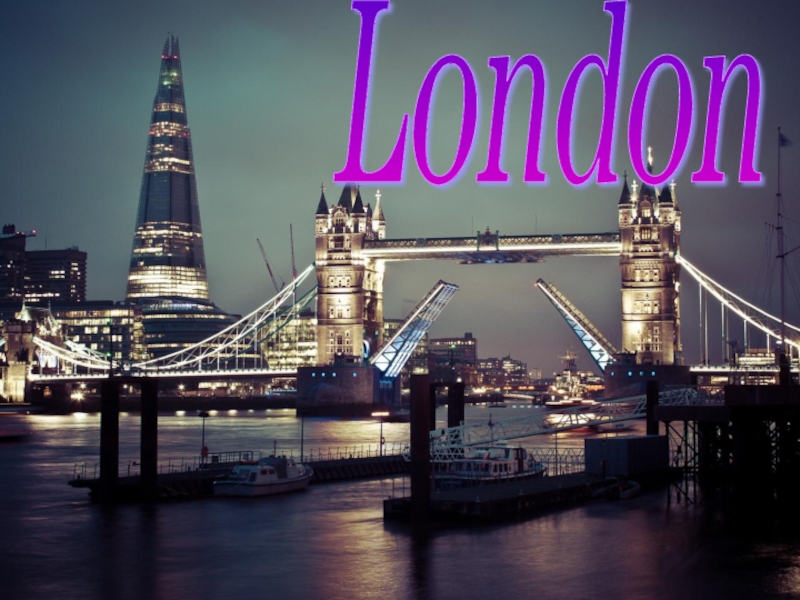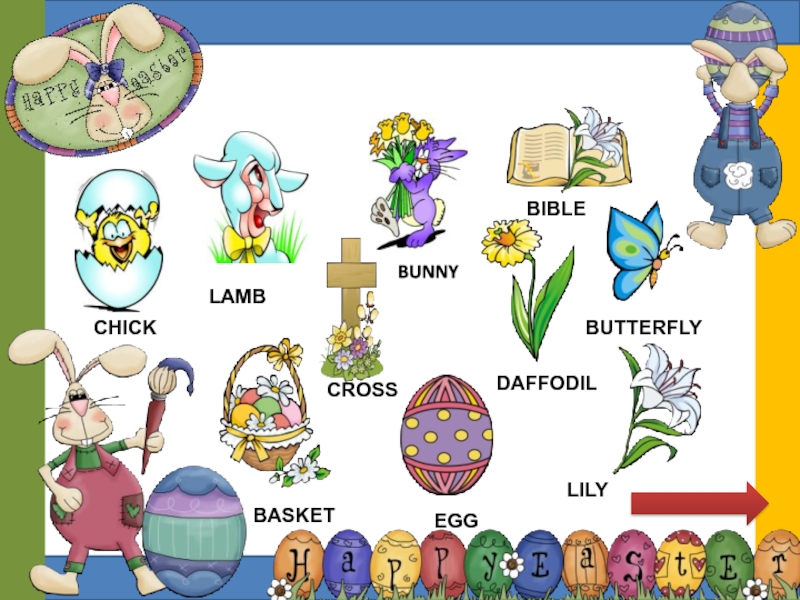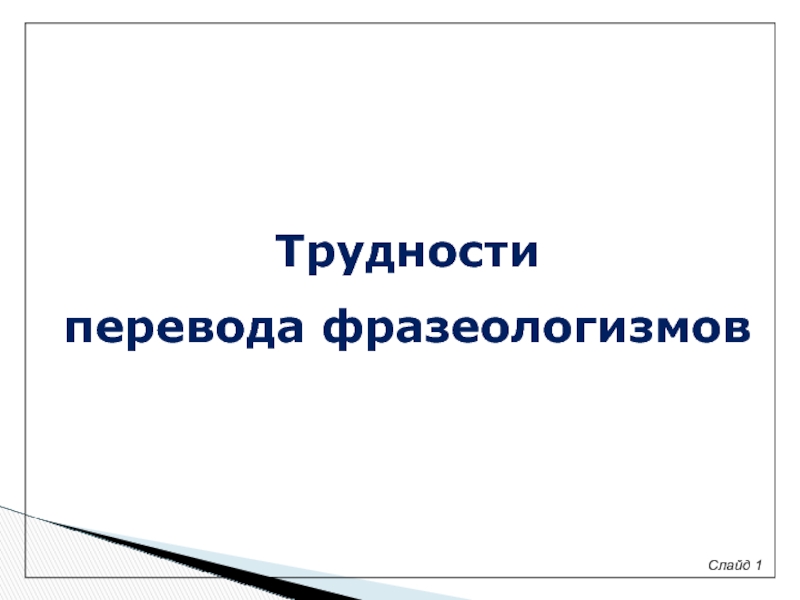- Главная
- Разное
- Дизайн
- Бизнес и предпринимательство
- Аналитика
- Образование
- Развлечения
- Красота и здоровье
- Финансы
- Государство
- Путешествия
- Спорт
- Недвижимость
- Армия
- Графика
- Культурология
- Еда и кулинария
- Лингвистика
- Английский язык
- Астрономия
- Алгебра
- Биология
- География
- Детские презентации
- Информатика
- История
- Литература
- Маркетинг
- Математика
- Медицина
- Менеджмент
- Музыка
- МХК
- Немецкий язык
- ОБЖ
- Обществознание
- Окружающий мир
- Педагогика
- Русский язык
- Технология
- Физика
- Философия
- Химия
- Шаблоны, картинки для презентаций
- Экология
- Экономика
- Юриспруденция
Functional styles презентация
Содержание
- 1. Functional styles
- 2. Style (Latin 'stylus‘) "Style is a contextually restricted linguistic variation." (N.E. Enkvist)
- 3. Style "Style is a product of individual
- 4. Style "Style is a quality of language
- 5. Style is a set of characteristics by
- 6. Style is
- 7. Style is identified by a COMBINATION of
- 8. Functional style a system of coordinated,
- 9. formal Neutral informal
- 10. Informal Style used in personal two-way every-day
- 11. Informal Style gesture, tone, voice are as
- 12. Informal Style imaginative word play (e.g. These
- 13. Informal Style lexical expressions of modality (e.g.
- 14. Informal Style substantive adjectives (e.g. greens for
- 15. Informal Style Vocabulary Colloquial words
- 16. Literary Colloquial used by educated
- 17. Familiar Colloquial more emotional, much more free
- 18. Low Colloquial Speech illiterate speech contains more
- 19. Slang mainly used by young and uneducated
- 20. Slang most slang words are metaphors and
- 21. Slang slang words and idioms are short-lived,
- 22. Slang general slang – for any social
- 23. Argot special vocabulary used by a particular
- 24. Dialect Words Dialect is a variety of
- 25. Dialect Words dialect words may enter colloquial
- 26. Formal Style used in scientific discourse, in
- 27. Formal Style Vocabulary Literary / learned words
- 28. Formal Style Vocabulary literary / learned words
- 29. Formal Style Vocabulary words of scientific prose
- 30. Formal Style Vocabulary words of poetic diction:
- 31. Formal Style Vocabulary Obsolete words are words
- 32. Formal Style Vocabulary Archaic words are words
- 33. Historical words words denoting objects and phenomena
- 34. Historical words names of ancient transport means,
- 35. Professional Terminology Term is a word or
- 36. Professional Terminology terms should be monosemantic independent
- 37. Neutral Vocabulary opposed to formal and informal
- 38. Neutral words constitute the core of the
- 40. Functional styles
- 41. Classification of functional styles official
- 42. Official style represented in all kinds of
- 43. Official style (“officialese”) The aim is to
- 44. Official style special clichés, terms
- 45. Diplomatic documents Special terms and phrases:
- 46. Legal language extremely formal style abundance of
- 47. The Boeing Company By-Laws (Устав) Article 1
- 48. Official style use of abbreviations,
- 49. Official style fixed compositional patterns
- 50. Official style Almost every official document
- 51. Scientific style found in scientific research
- 52. Scientific style the aim is: to prove
- 53. Scientific style objective, precise, unemotional, devoid of
- 54. Scientific style referencing (fооt-nоtes, quotations)
- 55. Medical text «Before the individual medical diagnostic
- 56. Publicist style essay, feature article, most writings
- 57. Style of oratory the oral subdivision of
- 58. Style of oratory direct address to the
- 59. Style of oratory features of colloquial
- 60. Style of oratory Skills of public speaking:
- 61. Essay is a literary composition of moderate
- 62. Essay brevity of expression; use of the
- 63. Newspaper style observed in the majority of
- 64. Publicist style goal - to give
- 65. Newspaper style Informative, unbiased and evaluative to
- 66. BRIEF NEWS ITEMS state facts without
- 67. BRIEF NEWS ITEMS characterized by an
- 68. BRIEF NEWS ITEMS Abbreviations (NATO,
- 69. BRIEF NEWS ITEMS Verbal constructions
- 70. THE HEADLINE to inform the reader
- 71. THE HEADLINE can be almost a
- 72. THE HEADLINE elliptical sentences (with auxiliary
- 73. THE HEADLINE deliberate breaking-up of
- 74. ADVERTISEMENTS AND ANNOUNCEMENTS Goal :
- 75. ADVERTISEMENTS: classified and non-classified Classifieds
- 76. Non-classified adverts The reader's attention is attracted
- 77. Style of Advertisement
- 78. TO BElles-lettres or
- 79. Genres of Literature
- 80. Genres of literature http://www.youtube.com/watch?v=AsJko91QjgE More detailed description of genres http://www.youtube.com/watch?v=dNF4zpdDsSU
- 81. Belles-lettres style а) the language style of
- 82. Belles-lettres style Function: cognitive and aesthetic
Слайд 2Style (Latin 'stylus‘)
"Style is a contextually restricted linguistic variation." (N.E.
Слайд 3Style
"Style is a product of individual choices and patterns of choices
Слайд 4Style
"Style is a quality of language which communicates precisely emotions or
(J. M. Murry)
Слайд 5Style
is a set of characteristics by which we distinguish one author
Слайд 6Style is
way of using language
By register
formal –neutral – informal
By personal characteristics:
Individual style (of a writer)
By the context of communication:
Functional style
Слайд 7Style
is identified by a COMBINATION of properties
Lexical
means
Syntactical
means
Phonological
means
style
Слайд 8Functional style
a system of coordinated, interrelated and interconditioned language means
Слайд 10Informal Style
used in personal two-way every-day communication
vocabulary may be determined socially
Слайд 11Informal Style
gesture, tone, voice are as important as words
carelessness in grammar
not much variety in vocabulary (some words are overused: thing, do, get, right, really)
repetitions, filling words (you know, kind of, well)
Слайд 12Informal Style
imaginative word play (e.g. These clips are really …clippy)
ready-made formulas
standard expressions of surprise, gratitude (e.g. Thanks a million), apology (So sorry), etc.
Слайд 13Informal Style
lexical expressions of modality (e.g. definitely, in a way, I
ellipses (Hope you enjoy it)
Слайд 14Informal Style
substantive adjectives (e.g. greens for ’green leaf vegetables’, woolies for
lexical intensifiers, emphatic verbs and adverbs with lost denotational meaning (e.g. awfully, lovely, terrific, dead right)
Слайд 15Informal Style Vocabulary
Colloquial words
- literary colloquial (cultivated
- familiar colloquial
- low colloquial (illiterate speech)
Slang words
Dialect words
Слайд 16Literary Colloquial
used by educated people in an informal conversation
to have a crush on smb = to fall in love with smb
to turn up = come,
Слайд 17Familiar Colloquial
more emotional, much more free and careless
used mostly by young
a great number of jocular or ironical expressions and nonce-words
e.g. doc – doctor, ta-ta – good-bye
Слайд 18Low Colloquial Speech
illiterate speech
contains more vulgar, harsh words (bloody, hell, f-word)
sometimes
Слайд 19Slang
mainly used by young and uneducated
characterized by the use of expressive,
Слайд 20Slang
most slang words are metaphors and jocular, often with a coarse,
money – beans, bras, dibs, dough, wads
drunk – boozy, cock-eyed, soaked
Слайд 21Slang
slang words and idioms are short-lived, soon they ether disappear or
chap, fun, mob, shabby, hitch-hiker, once in a blue moon
Слайд 22Slang
general slang – for any social or professional group (cool)
special slang
Слайд 23Argot
special vocabulary used by a particular social or age group, the
its main purpose - to be unintelligible to the outsiders
e.g. shin – knife, book – life sentence
Слайд 24Dialect Words
Dialect is a variety of a language which prevails in
Allus = always (Yorkshire)
Bonkkle = bottle (Birmingham)
Слайд 25Dialect Words
dialect words may enter colloquial speech, slang, then neutral vocabulary
car, tram, trolley
Слайд 26Formal Style
used in scientific discourse, in monologue, often prepared in advance
words
the vocabulary and syntax are elaborate and standard-oriented
Слайд 27Formal Style Vocabulary
Literary / learned words [lə:nid]
-
- official words
- poetic diction
archaic and obsolete words
professional terminology
Слайд 28Formal Style Vocabulary
literary / learned words – used in descriptive passages
mostly polysyllabic words
create complex and solemn associations
delusion, reverberate, splenetic, insiduous
Слайд 29Formal Style Vocabulary
words of scientific prose
experimental, divergent, in terms
officialese (канцеляризмы) –bureaucratic language, peculiar to official documents: accommodation (room), donation (gift), comestibles (food), dispatch (send off)
Слайд 30Formal Style Vocabulary
words of poetic diction:
used in poetry
characterized by a lofty,
they are more abstract
e.g. array (clothes), steed (horse), lone (lonely), naught (nothing), thee (you)
Слайд 31Formal Style Vocabulary
Obsolete words are words that dropped from the language,
Слайд 32Formal Style Vocabulary
Archaic words are words which survive in special contexts,
associated with poetic diction
e.g. aye (yes), nay (no), morn (morning), betwixt (between)
Слайд 33Historical words
words denoting objects and phenomena which are things of the
they are names for social relations, institutions, objects of material culture of the past
Слайд 34Historical words
names of ancient transport means, ancient clothes, weapons, musical instruments,
crinoline - кринолин
musket - мушкет
hansom двухколесный экипаж ( с местом для кучера сзади )
Слайд 35Professional Terminology
Term is a word or a word-group which is specifically
Слайд 36Professional Terminology
terms should be monosemantic
independent of the context
have only denotational meaning
terms
cardiovascular (сердечно-сосудистый), futures (фьючерсы = фин.), modem
Слайд 37Neutral Vocabulary
opposed to formal and informal words
used in all kinds of
Слайд 38Neutral words
constitute the core of the language corpus, denote objects and
characterized by high frequency
e.g. to walk, summer, child, green
Слайд 41Classification of
functional styles
official style
scientific style
publicist style
newspaper style
belles-lettres
Слайд 42Official style
represented in all kinds of official documents and papers:
а) the
b) the language style of diplomatic documents;
с) the language style of legal documents;
d) the language style of military documents
Слайд 43Official style (“officialese”)
The aim is to reach agreement between two contracting
- the state and the citizen,
- or citizen and citizen;
- a society and its members;
- two or more enterprises or bodies;
- two or more governments (pacts, treaties);
- a person in authority and a subordinate, etc.
- a board of directors and employees
Слайд 44Official style
special clichés, terms and set expressions (beg to
Слайд 45Diplomatic documents
Special terms and phrases:
contracting parties, to ratify an agreement,
Слайд 46Legal language
extremely formal style
abundance of terms including Latin words (habeas corpus)
often
Слайд 47The Boeing Company By-Laws (Устав)
Article 1 Section 4: “Except as otherwise
Слайд 48Official style
use of abbreviations, conventional symbols and contractions:
Business: oc
TC (till cancelled) пока не аннулировано, AAAA –American Association of Advertising Agencies (Американская Ассоциация Рекламных Агентств)
Military: adv. (advance); atk (attack); obj. (object); ATAS (Air Transport Auxiliary Service),
Слайд 49Official style
fixed compositional patterns
Business letters
the heading giving (the address
Introduction (Dear Sir(s) / Madam
Text
Conclusion (Sincerely / Faithfully yours)
Signature and work position
Слайд 50Official style
Almost every official document has its own compositional design.
Слайд 51Scientific style
found in scientific research papers, dissertations, articles, brochures, monographs
а) the language style of arts
b) the language style of sciences;
с) the language style of popular scientific prose
Слайд 52Scientific style
the aim is:
to prove a hypothesis,
to create new concepts,
to establish relations between different phenomena, etc.
Слайд 53Scientific style
objective, precise, unemotional, devoid of any individuality
generalized language (абстрактный
logical sequence of utterances (connectives: as is clear from, therefore, thus, consequently, etc.)
use of terms specific to each given branch of science
Слайд 54Scientific style
referencing (fооt-nоtes, quotations)
impersonality (passive constructions)
very prolific
- drone (Unmanned Aerial Vehicles)
- bionic eye (microchip implanted into the visual cortex of the brain – enables the blind to “see”)
Слайд 55Medical text
«Before the individual medical diagnostic and therapeutic procedures are discussed,
Прежде чем перейти к рассмотрению конкретных диагностических и лечебных мероприятий следует разобрать общепринятый подход к лечению.
Слайд 56Publicist style
essay, feature article, most writings of "new journalism", radio and
а) the language style of oratory;
b) the language style of essay;
с) the language style of feature articles in newspapers and journals.
Слайд 57Style of oratory
the oral subdivision of the publicist style
purpose of
requires a lot of eloquence
speeches on political and social occasions (party meetings, weddings, funerals, jubilees, in sermons and debates, in speeches of counsel and judges in courts of law)
Слайд 58Style of oratory
direct address to the audience by special formulas (Ladies
final formulas to thank the audience (Thank you very much; Thank you for your time)
use of we, let’s (identifying with the audience)
Слайд 59Style of oratory
features of colloquial style (I’ll; won’t; haven’t; isn’t,
the emotional colouring may be solemn, or ironic, but not “lowered” - jocular, rude, vulgar, or slangy;
stylistic devices to rouse the audience and keep it in suspense (repetition, climax, rhetorical questions, parallel constructions, etc.)
Слайд 60Style of oratory
Skills of public speaking:
voice
intonation and pausation
Listen to an example.
Слайд 61Essay
is a literary composition of moderate length on philosophical, social, scientific
preserves a clearly personal character
has no pretence to deep or strictly scientific treatment of the subject
a number of comments, without any definite conclusions
Слайд 62Essay
brevity of expression;
use of the first person singular (a personal approach
an expended use of connectives, which facilitates the process of grasping the correlation of ideas;
abundant use of emotive words;
use of similes and metaphors as one of the media for the cognitive process.
Слайд 63Newspaper style
observed in the majority of information materials printed in newspapers
the language style of newspaper headlines;
the language style of advertisements
Слайд 64
Publicist style
goal - to give ‘views’, i.e. to shape the audience’s
Newspaper style
goal – to give news, i.e. to inform the audience
PUBLICIST vs NEWSPAPER STYLE
Слайд 65Newspaper style
Informative, unbiased and evaluative to a certain extent
specific vocabulary
The minister is reported to have denied the fact
The President was quoted as saying that there was no reason for panic.
Слайд 66BRIEF NEWS ITEMS
state facts without giving explicit comments
mostly implicit
stylistically neutral, unemotional
matter-of-fact and stereotyped forms
neutral and common literary vocabulary
Слайд 67BRIEF NEWS ITEMS
characterized by an extensive use of:
Special political and
Non-term political vocabulary (public, people, progressive, nation-wide)
Newspaper clichés (smear campaign, pillars of society); lots of them are pompous, hackneyed, false and misleading (political euphemisms)
Слайд 68BRIEF NEWS ITEMS
Abbreviations (NATO, EEC)
Neologisms (liquid bomb plot)
Brown addresses tonight’s TUC dinner, and is expected to face blunt words from Brendan Barber, general secretary, and Dave Prentis, TUC president and leader of Unison, on the failure to connect with the needs of ordinary people.
Слайд 69BRIEF NEWS ITEMS
Verbal constructions (infinitive, participial, gerundial)
Attributive noun
A team-building exercise involving imitation guns backfired when it prompted a full-scale armed police response.
Слайд 70THE HEADLINE
to inform the reader briefly what the text that
to arouse the reader's curiosity
to express the newspaper’s attitude to the information (elements of appraisal)
Слайд 71THE HEADLINE can be
almost a summary of the information
“Homemade
short phrases: “Freddie, Fannie and Friends”
citing: “Give Scotland own digital channel, says inquiry”
Слайд 72THE HEADLINE
elliptical sentences (with auxiliary verbs, articles, subject, predicate omitted):
“Man
“Russia to leave Georgia after EU deal”
“In praise of …open days”
Слайд 73THE HEADLINE
deliberate breaking-up of set expressions:
“Cakes and Bitter Ale”
“Conspirator-in-chief Still at Large” (Constable-in-Chief)
Слайд 74ADVERTISEMENTS AND ANNOUNCEMENTS
Goal :
to inform
to appeal to
to persuade the reader to respond accordingly
Слайд 75ADVERTISEMENTS:
classified and non-classified
Classifieds (“Jobs”, “Births”, “Obituaries”, etc)
- economizing space (= money):
- abbreviations
- neutral (with occasional emotionally coloured words to attract the reader's attention)
Слайд 76Non-classified adverts
The reader's attention is attracted by every possible means:
typographical
graphical
stylistic,
Слайд 78TO BElles-lettres or
Fiction embraces numerous and versatile genres of imaginative writing, all sorts of style – formal and informal, uses the tools of all the functional styles. Is it reasonable to distinguish it as an independent style?
No consensus.
Слайд 80
Genres of literature http://www.youtube.com/watch?v=AsJko91QjgE
More detailed description of genres http://www.youtube.com/watch?v=dNF4zpdDsSU
Слайд 81Belles-lettres style
а) the language style of poetry;
b) the language style of
с) the language style of drama.
Слайд 82Belles-lettres style
Function: cognitive and aesthetic
genuine, not trite; imagery, achieved by
richness of vocabulary and expressive means
a peculiar selection of vocabulary which reflects the author's personal evaluation of things or phenomena
The belles-lettres style is individual in essence

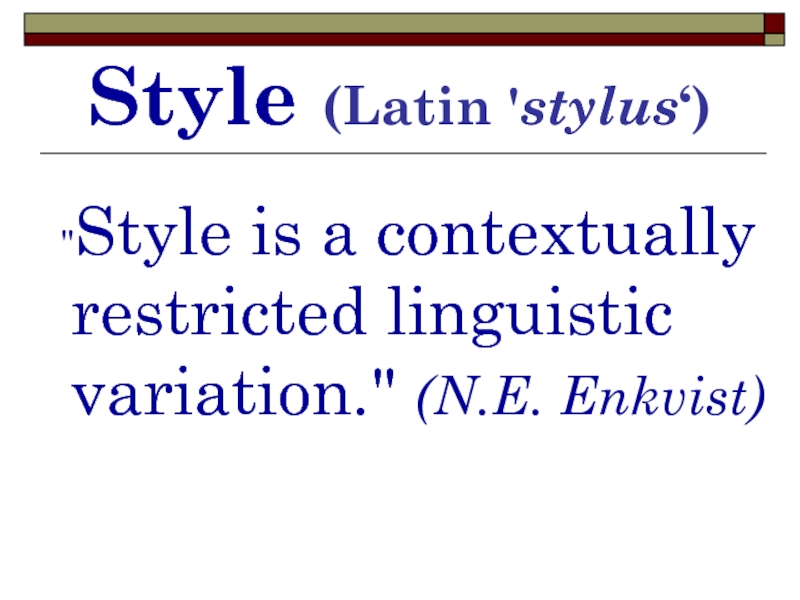
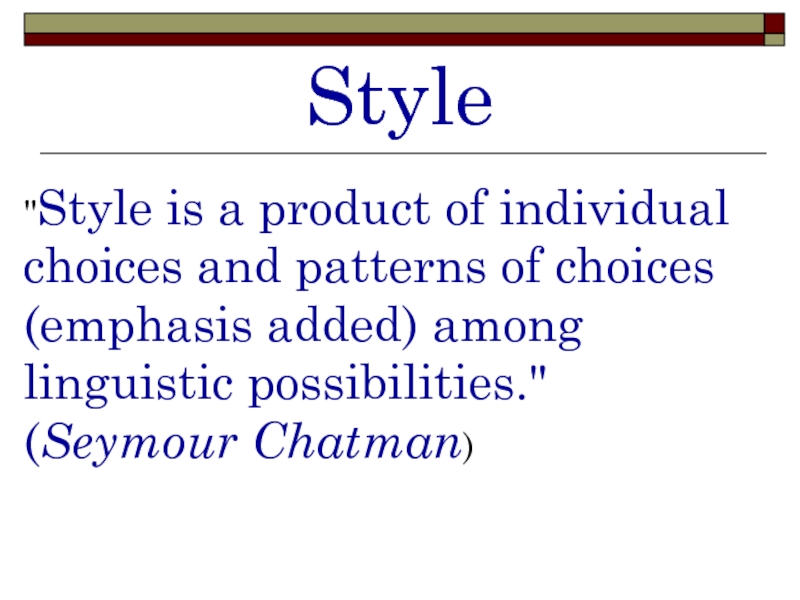
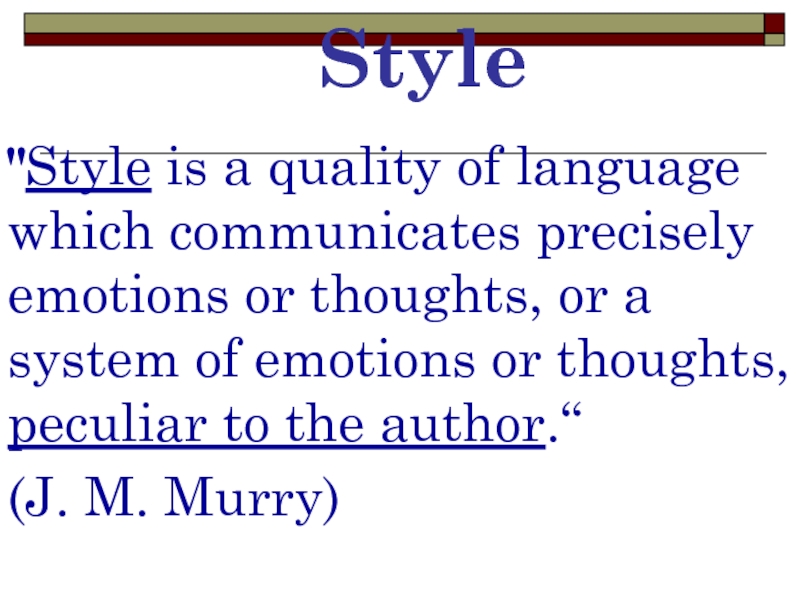

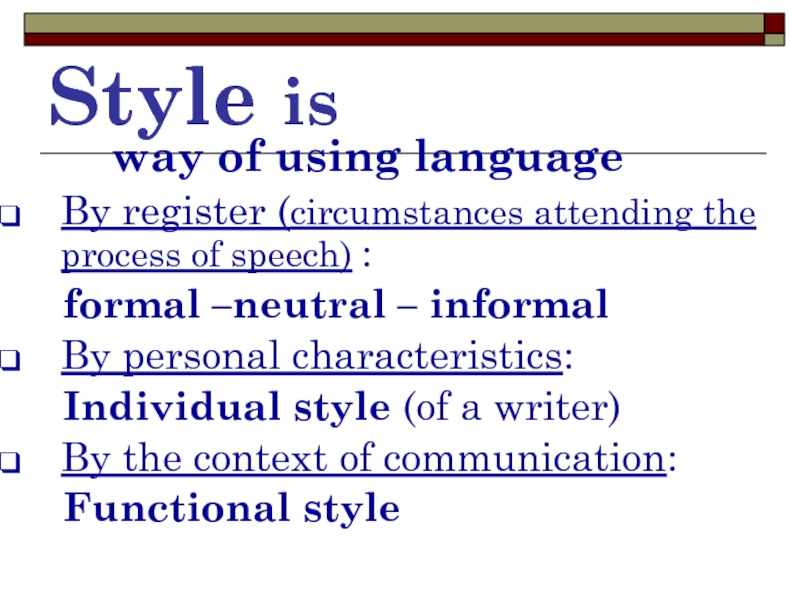
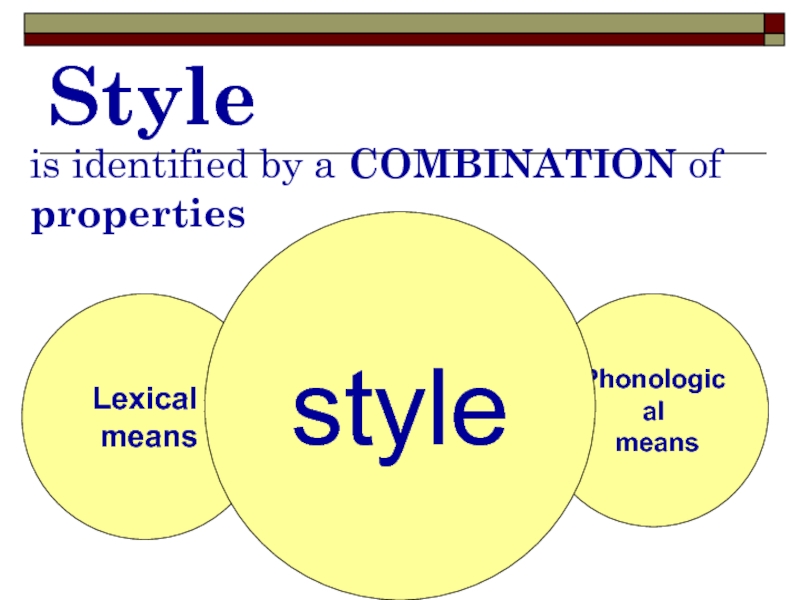
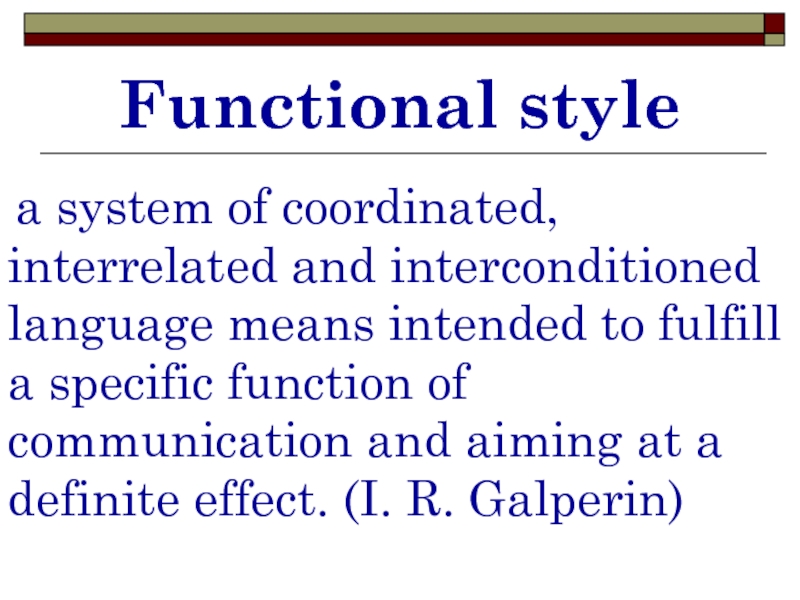
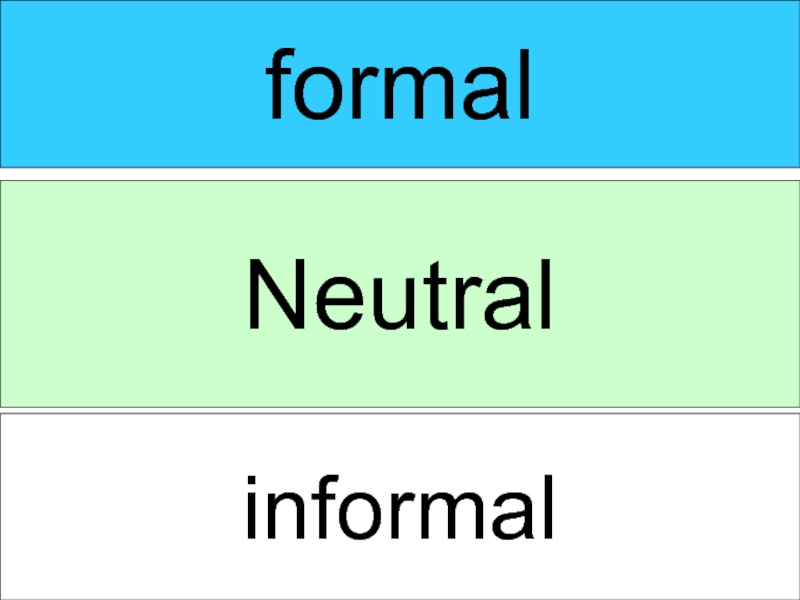
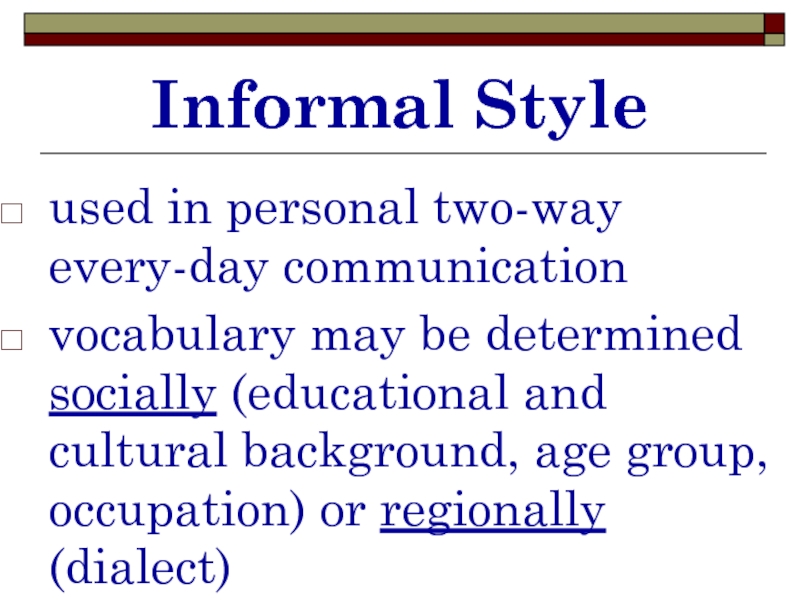
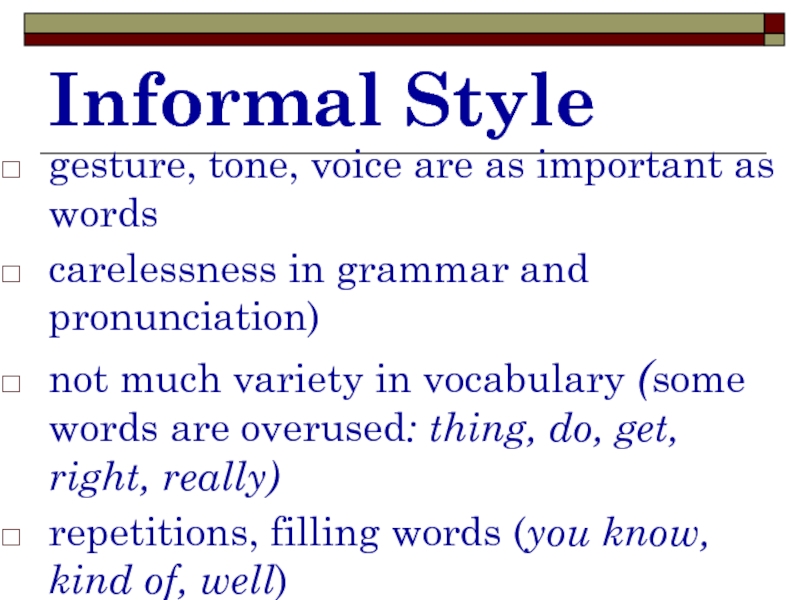
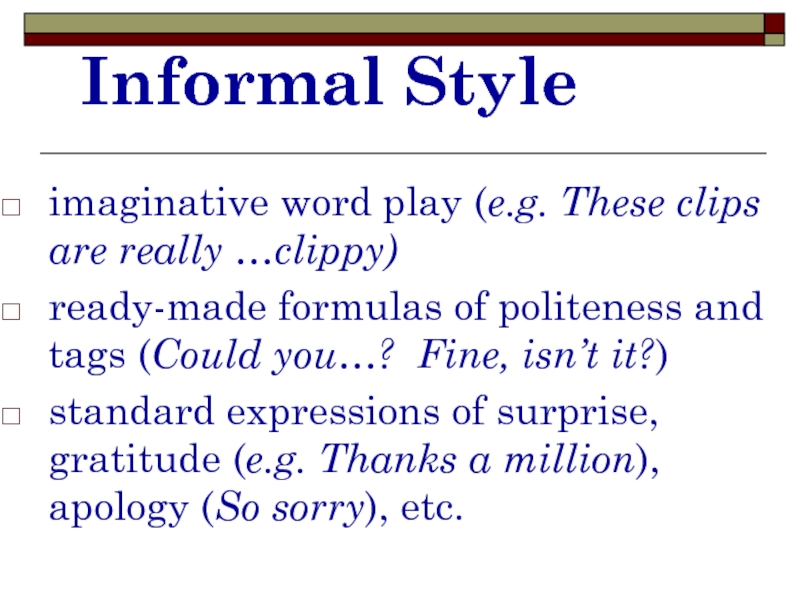
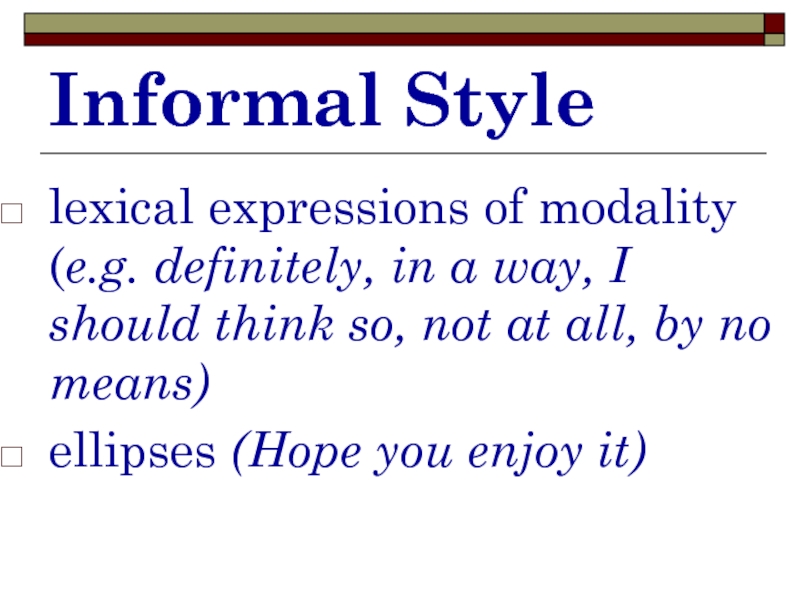

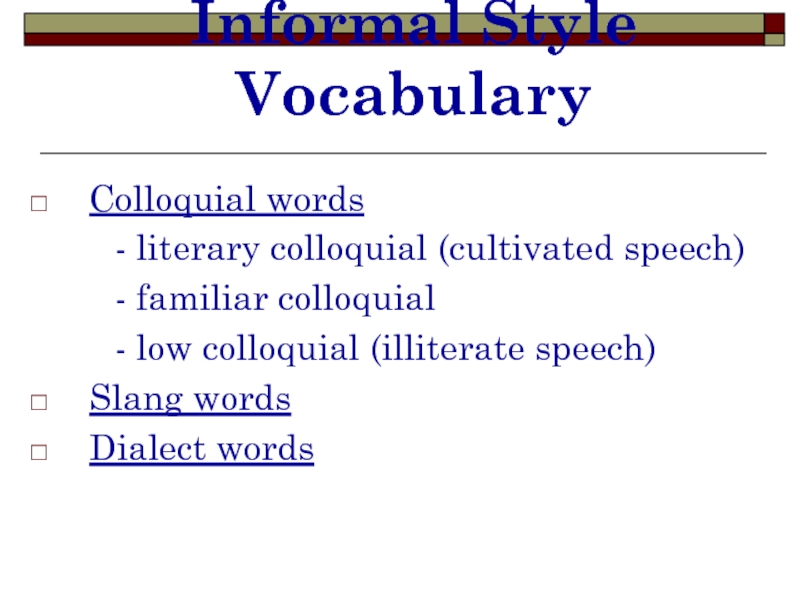
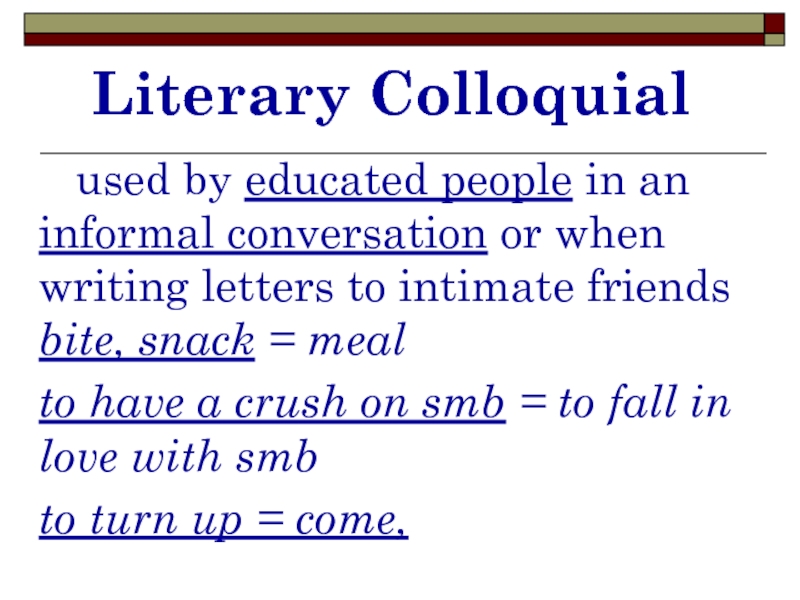
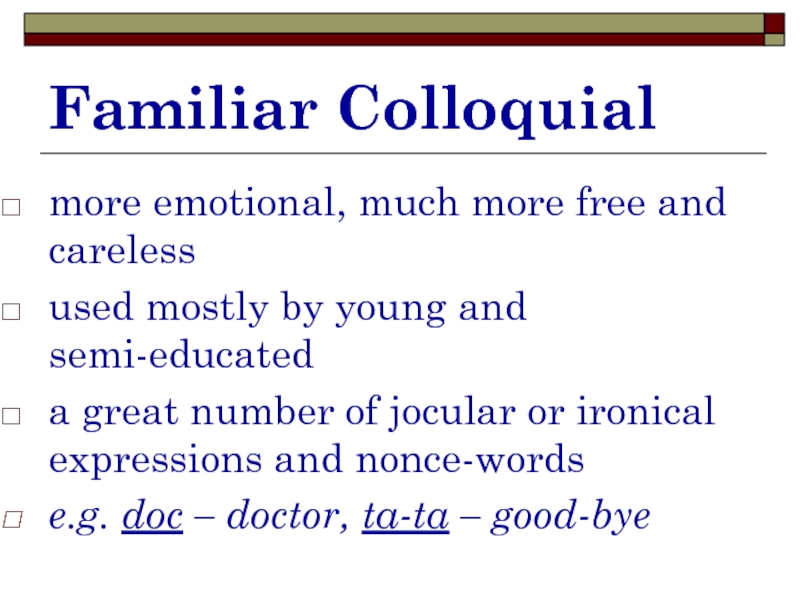
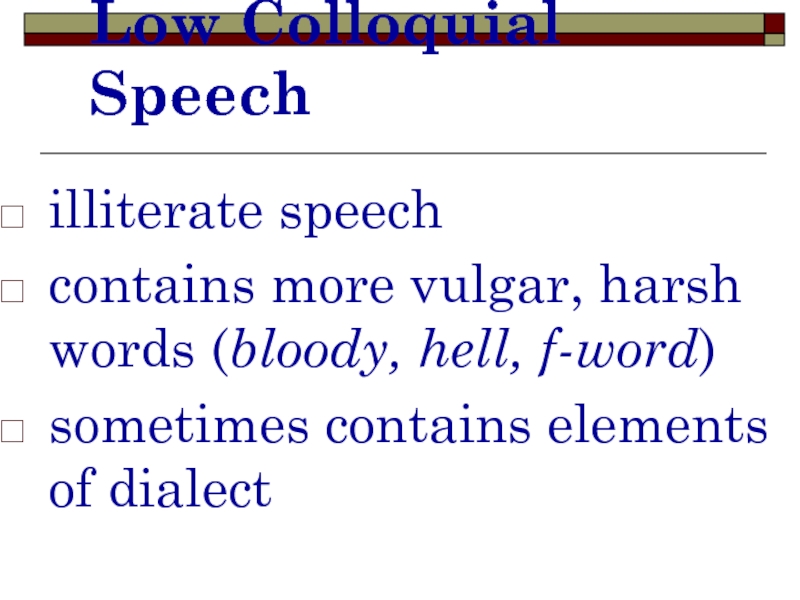


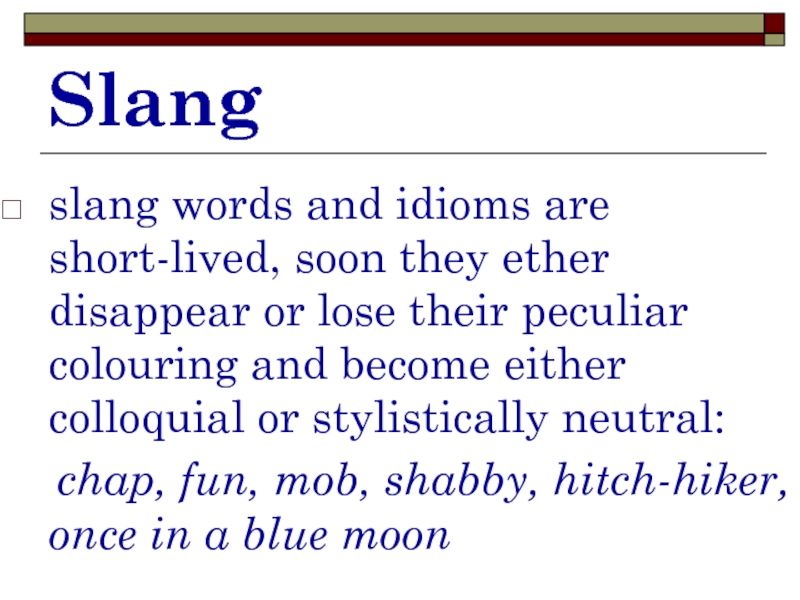
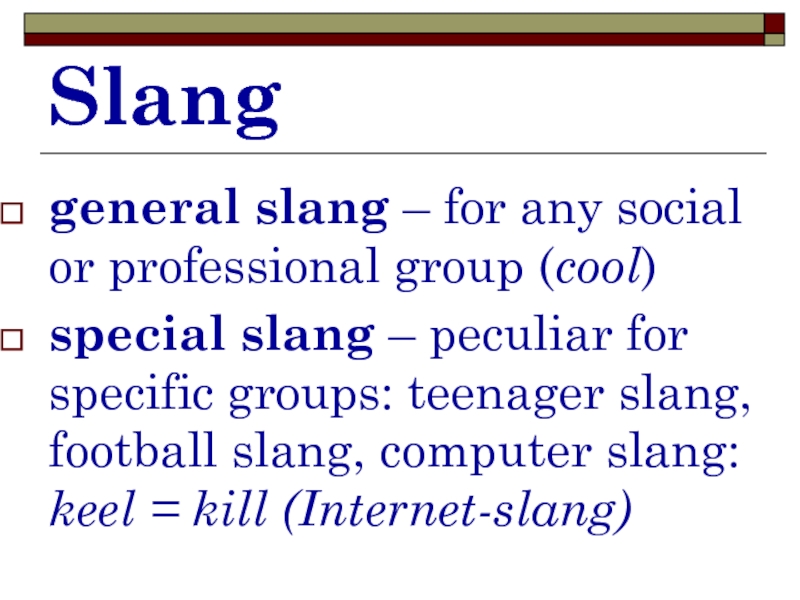
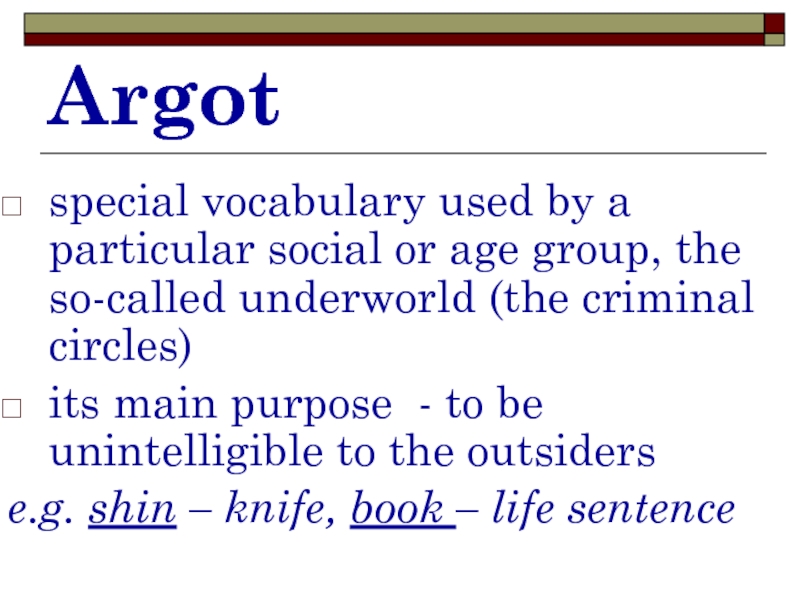

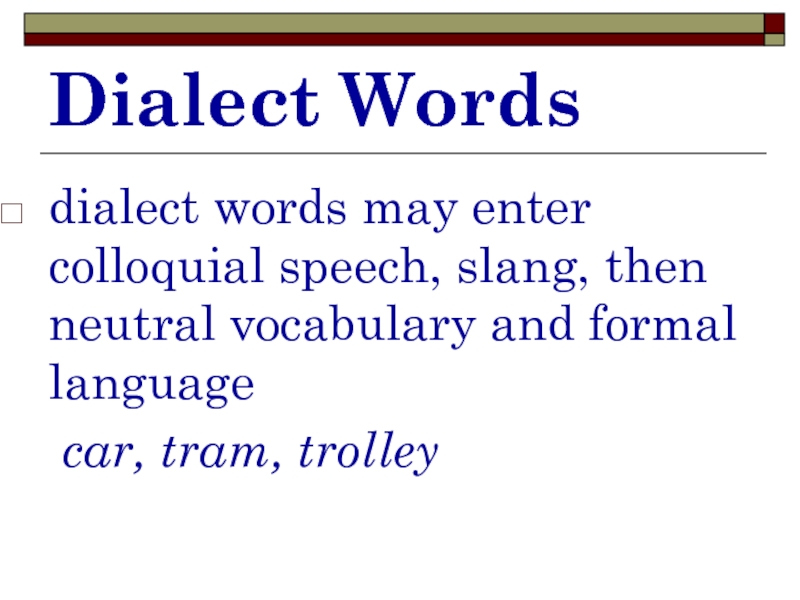
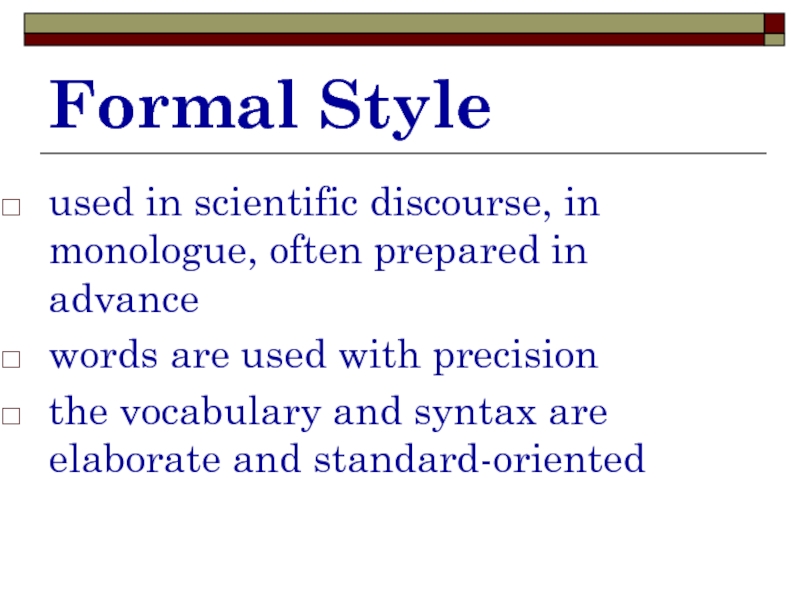
![Formal Style VocabularyLiterary / learned words [lə:nid] - words of scientific prose -](/img/tmb/5/407299/68708aded46a467c5e5a7f65f82d6c32-800x.jpg)
